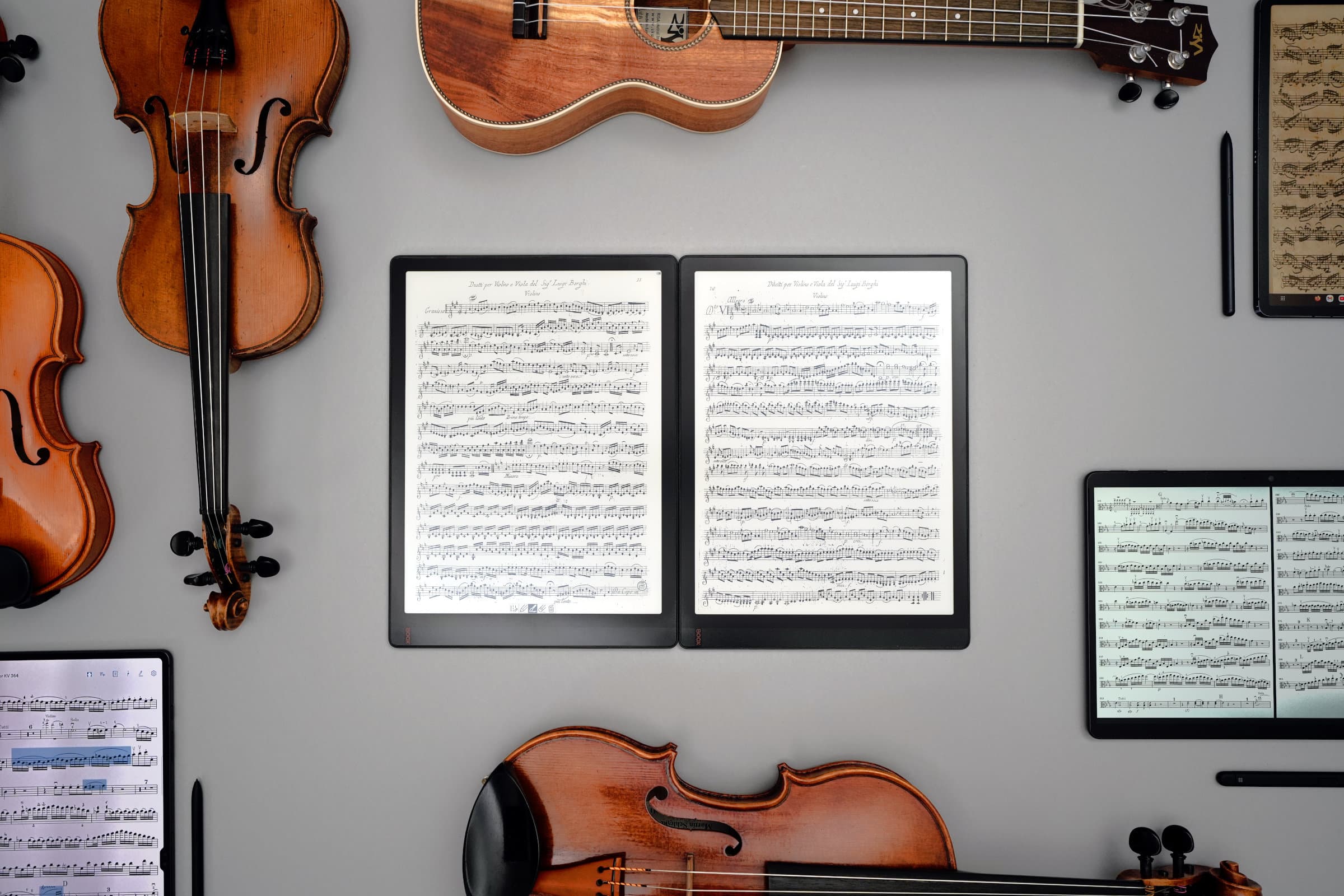
Photo: tablets-for-musicians.com
The best e-readers for musicians
Last updated on February 8, 2025
An e-reader can help professional and amateur musicians organize and read sheet music and scores. When practicing and performing, the music can be played from the e-reader without having sheets of music flying down. Page-turning problems and stacks of sheet music are a thing of the past.
In the last few months, new large format e-readers have hit the market, one of which was designed specifically for musicians. In this article, I will take a closer look at which e-readers are the best for a musician’s daily use, including practicing, rehearsing, and performing.
I am registered with the Amazon Associates Program. This website contains Amazon affiliate links (marked with a star). If you click on one of these links and make a purchase, I may receive a commission from Amazon.
Clicking on an affiliate link does not change the price you pay, and will help me continue to test tablets and e-readers. Thank you for your trust and support!
 I am a classical musician (violist) with 20 years of professional experience in orchestra and chamber music. For many years, I have been advising colleagues, students, and fellow musicians in the choice of their tablet.
I am a classical musician (violist) with 20 years of professional experience in orchestra and chamber music. For many years, I have been advising colleagues, students, and fellow musicians in the choice of their tablet.
Along with the many positives of using tablets / iPads, I’ve also seen the negatives: tablets crashing just before going on stage, batteries that don’t hold up during long rehearsal days, and missing page turner pedals in concert.
I spent my school years in France, and this article must be riddled with spelling and grammar mistakes, for which I apologize. Feel free to send me any corrections!
There is no test protocol! I use the most different tablets and iPads possible in my real life as a musician, which includes practicing, rehearsing and playing concerts.
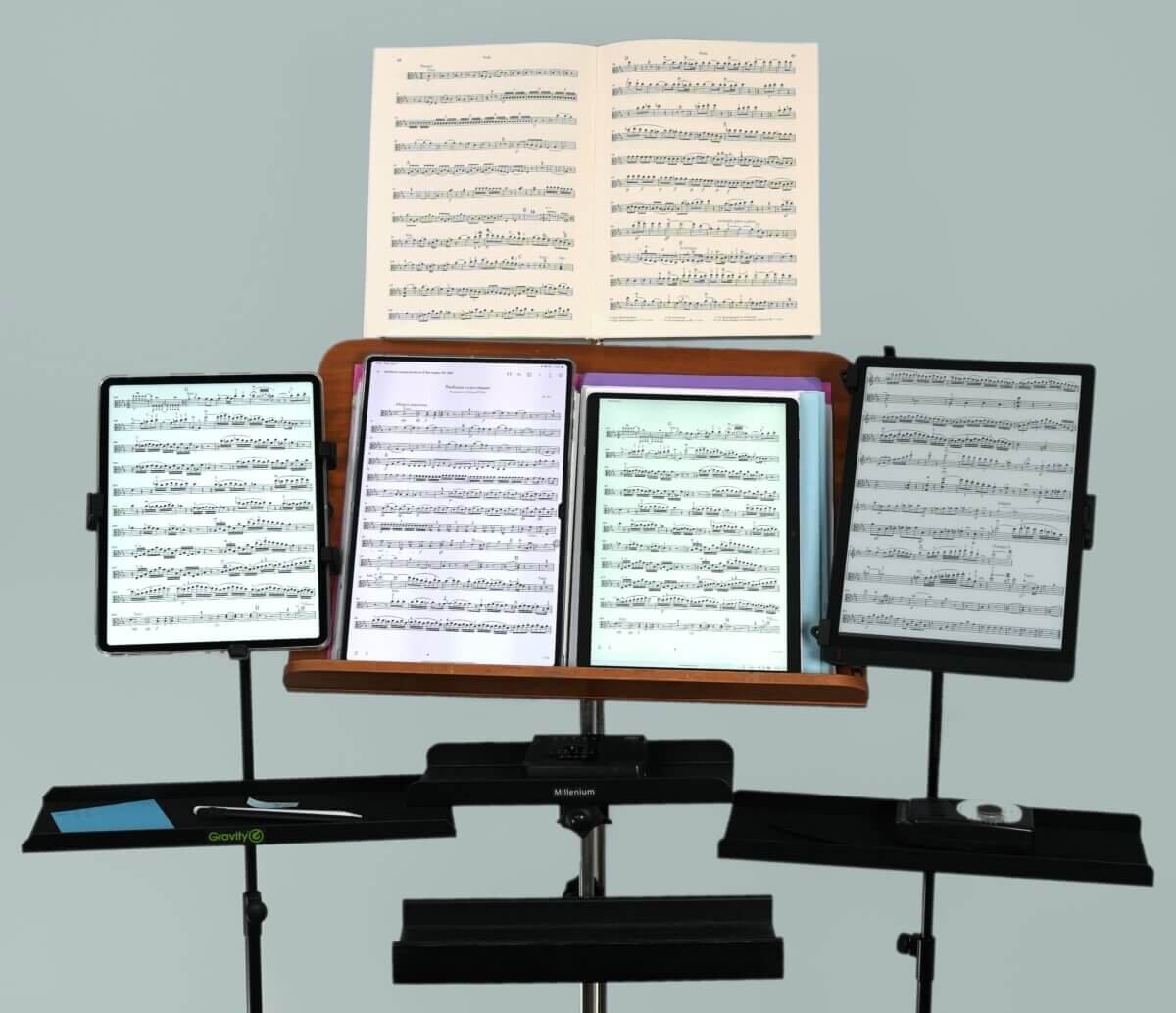
Practicing with multiple tablets at the same time can be laborious. Photo: tablets-for-musicians.com
The tablets and e-readers are purchased with my own funds and used as long as I please. This means that my tablet / iPad reviews are always independent, long term and real life reviews.
E-reader or tablet?
First, let’s highlight the difference between e-readers and tablets when it comes to displaying sheet music. Despite their many advantages, tablets often have glossy displays that can cause glare or reflections.
This can make reading sheet music difficult in very bright environments (outdoor concerts) or cause problems with reflections from lamps or spotlights.
E-readers, on the other hand, use electronic ink technology (E-ink) that minimizes glare and allows for more comfortable reading, even when performing in direct sunlight.
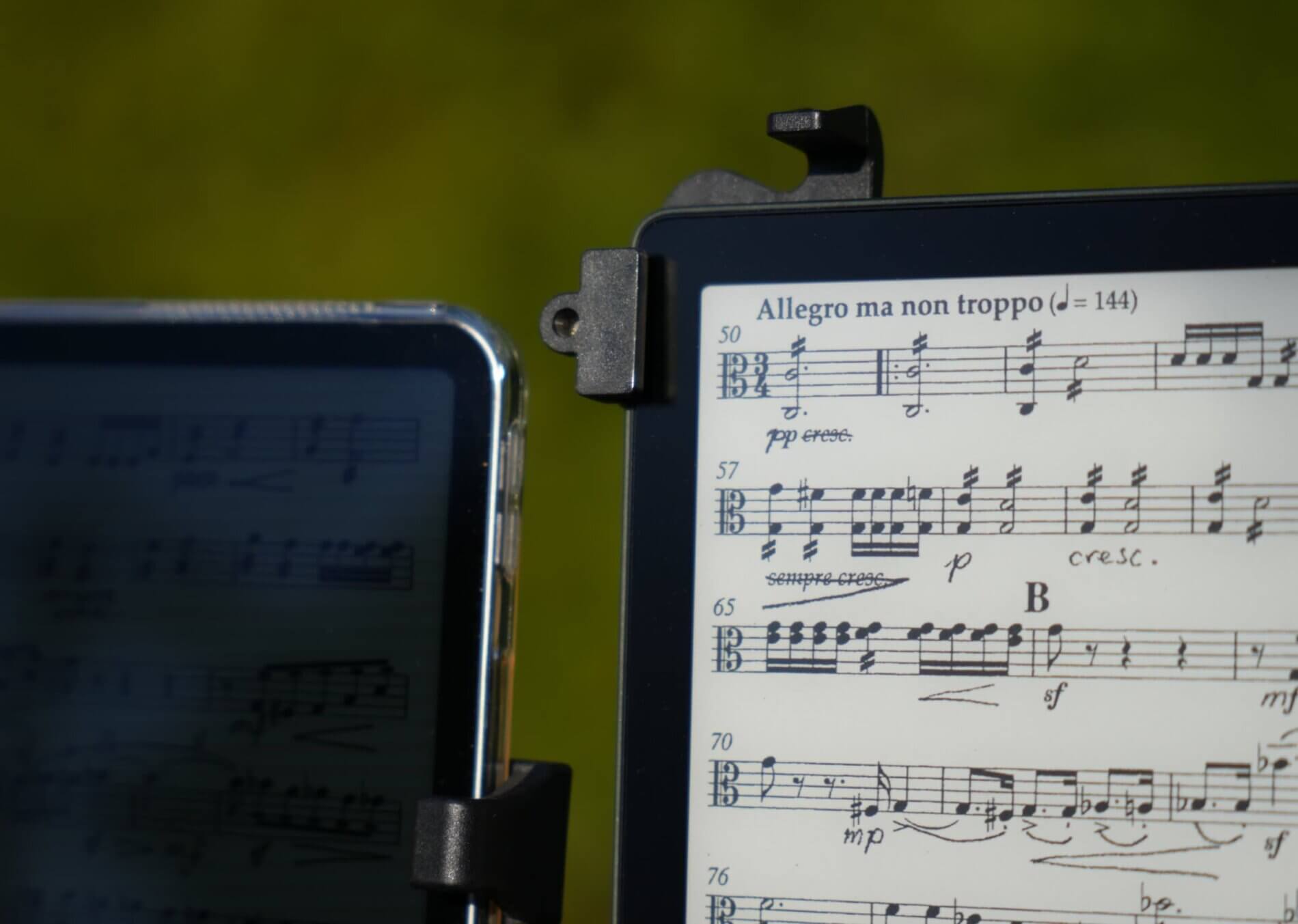
Outside, e-readers fare much better than tablets. Here an iPad Pro (left, maximum brightness) in full sunlight next an e-reader (Boox Tab X, right) – unedited picture. Photo: tablets-for-musicians.com
Which display sizes are suitable for reading sheet music?
The largest e-readers available on the market have a 13.3-inch display with a 4:3 aspect ratio. These screens are slightly smaller than a sheet of paper. To be more precise, the area of 13.3-inch displays is 90.8% of the area of a Letter-size paper, or 87.8% of the area of an A4-size sheet of paper.
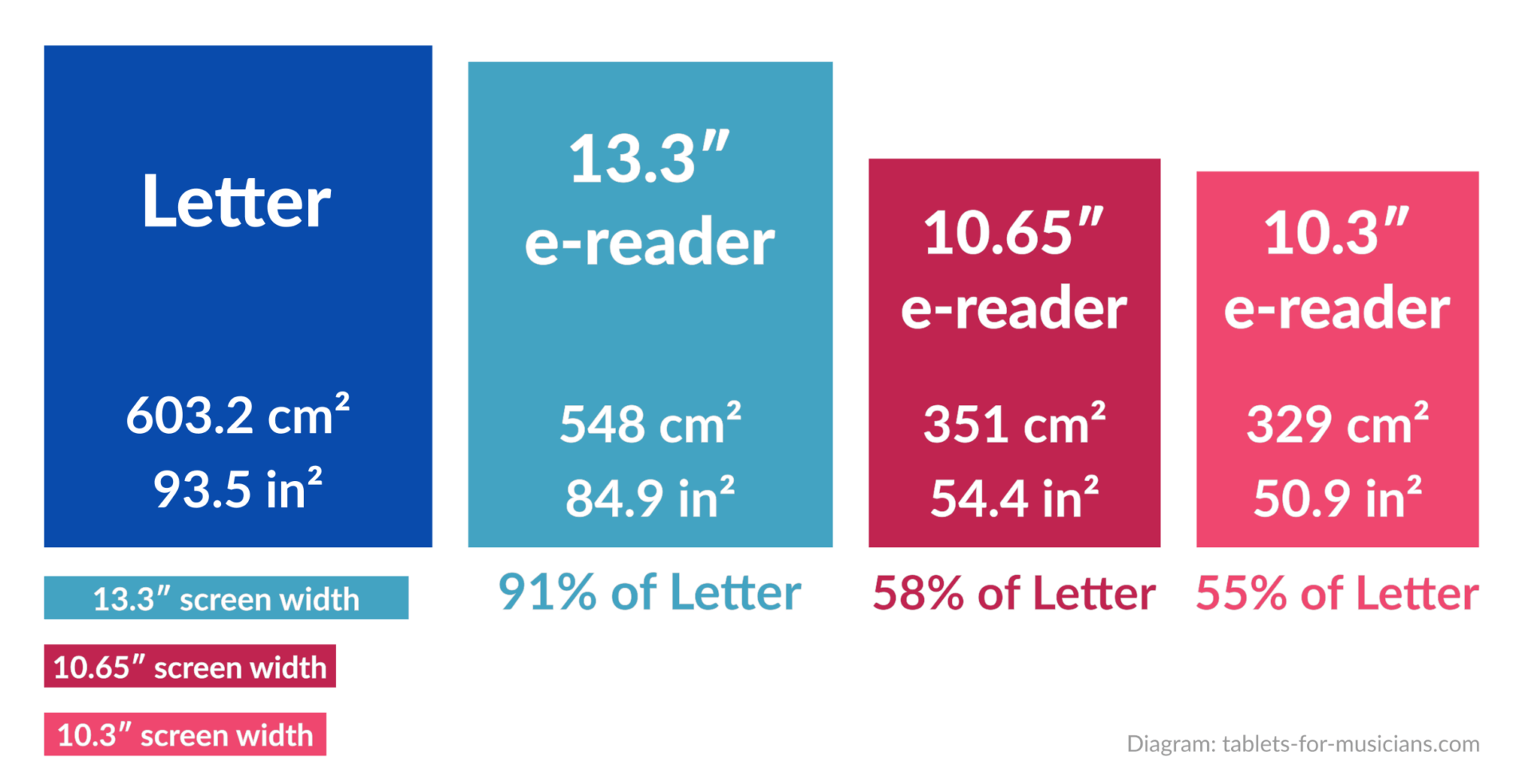
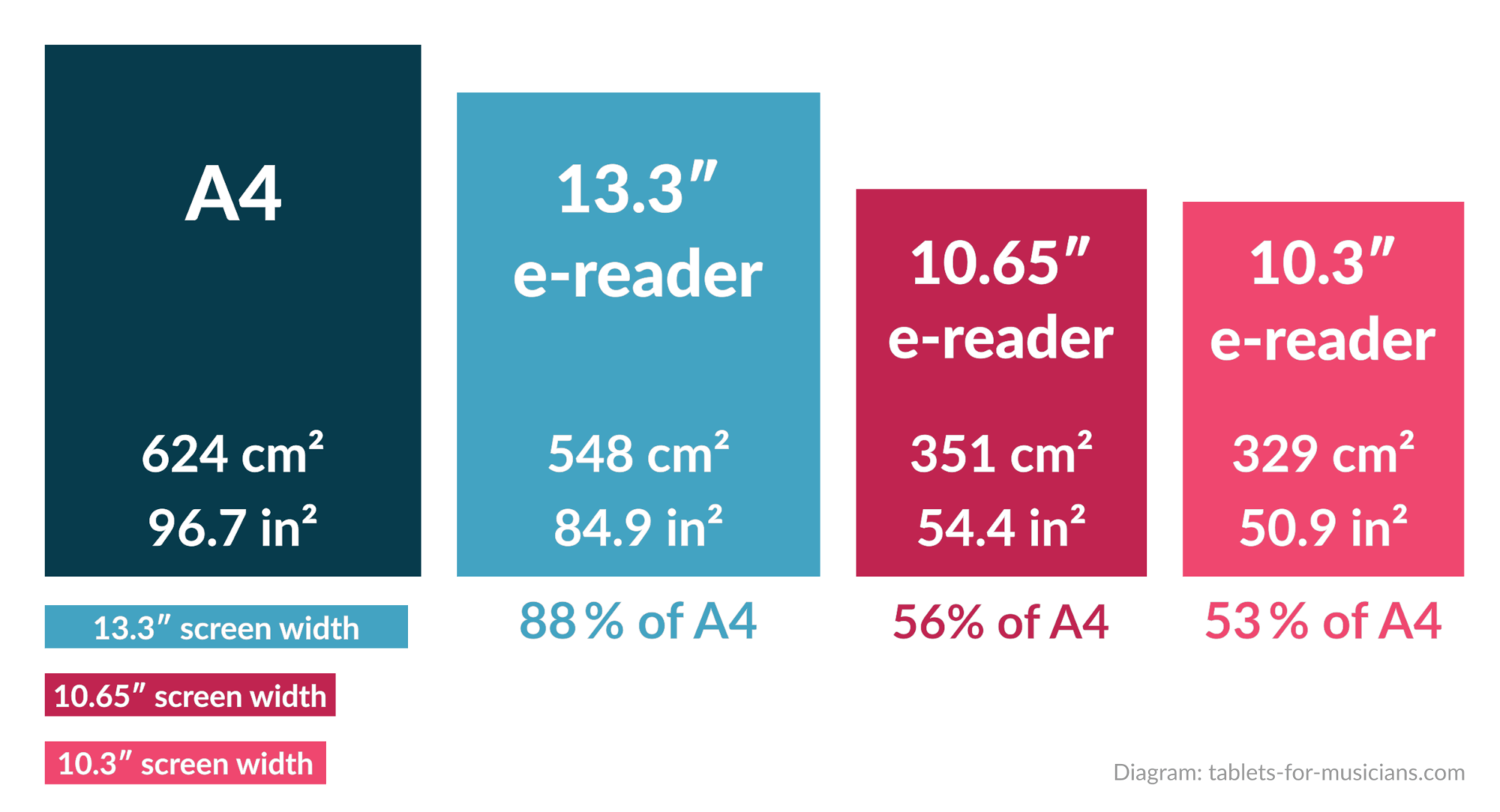
Sheet of paper, compared to 13.3-inch, 10.65-inch and 10.3-inch e-reader displays. The surfaces and dimensions are those of the screens and not those of the e-book-readers.
The screen size of smaller e-book readers goes straight to 10.65 or 10.3 inches – there are no standard screen sizes between 13.3 and 10.65 inches. (There is one exception though: the reMarkable Paper Pro, released in September 2024, has an 11.8-inch screen, see more details below).
A 10.3-inch screen cover 54.5% of the area of a Letter-sized sheet of music. These e-readers are definitely too small to display complex scores, but might be enough for song lyrics with chords.
For the vast majority of musicians, an e-reader with a 13.3-inch screen is therefore recommended.
List of the best e-readers for musicians
To be used for reading sheet music, an e-reader should support the following features:
- a stylus, to annotate sheet music
- Bluetooth, to connect a page turner
E-readers that do not meet these criteria are not included in the list. Amazon’s Kindle devices are thus not mentioned here.
1. Boox Tab X
The best e-reader for musicians (... is getting old)
The Onyx Boox Tab X offers a large 13.3-inch e-ink display, runs Android 11 (a long-obsolete version) and comes with a stylus, the “Pen2 Pro”.
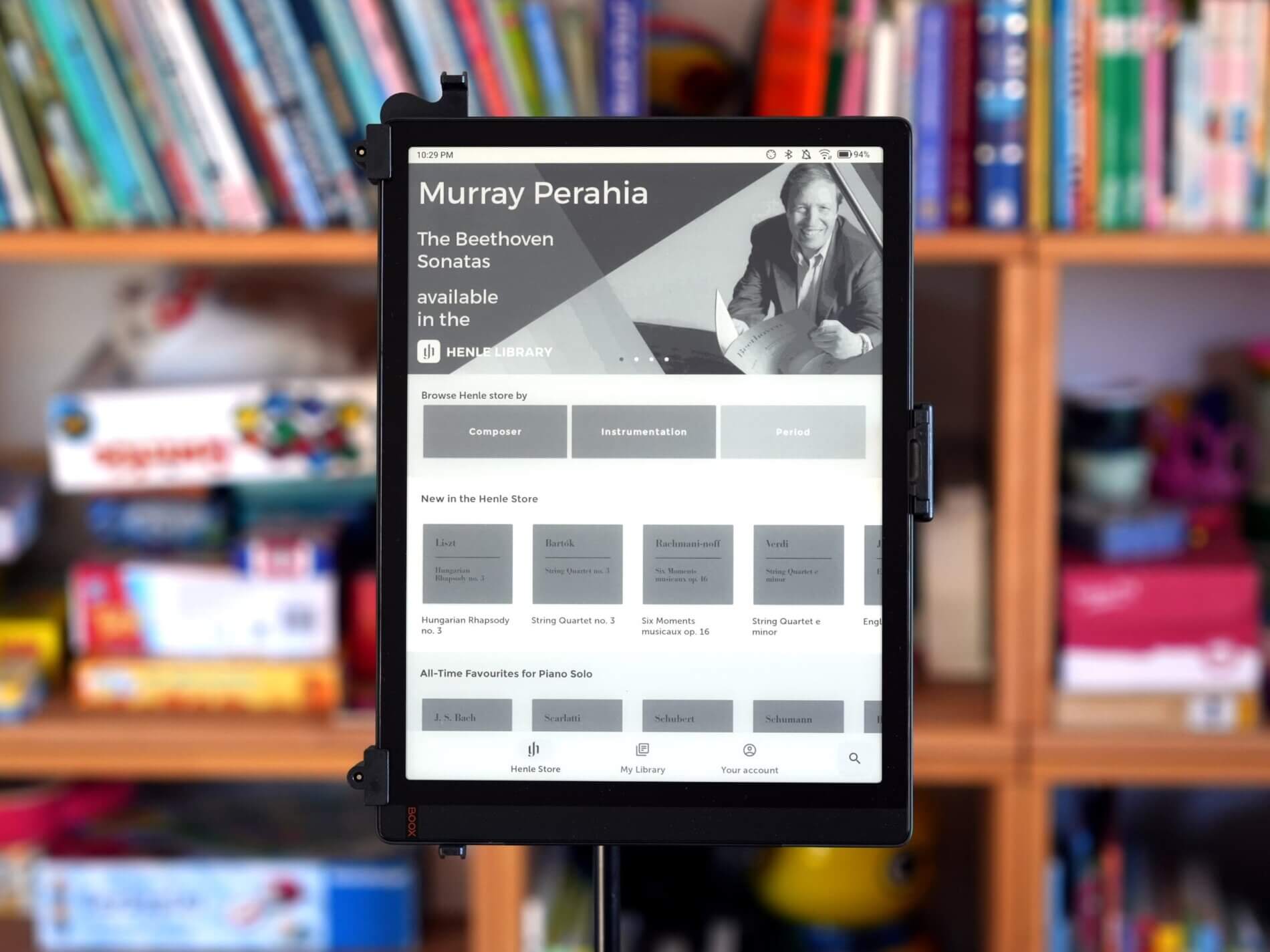
Homepage of the “Henle Library” app on an Onyx Boox Tab X e-reader. Photo: tablets-for-musicians.com
Thanks to Android, the full range of applications from the Play Store is available. You can download sheet music apps and access digital score libraries, which is not possible with non-Android readers like Kindles, Kobos or reMarkables.
Examples include MuseScore, Henle Library, Tomplay, Sibelius, SongBookPro or the IMSLP app. My favorite sheet music reading app, MobileSheets, is available in a version designed specially for e-ink devices.
Since Bluetooth is supported, it is possible (and very easy) to connect a pedal to turn the pages.
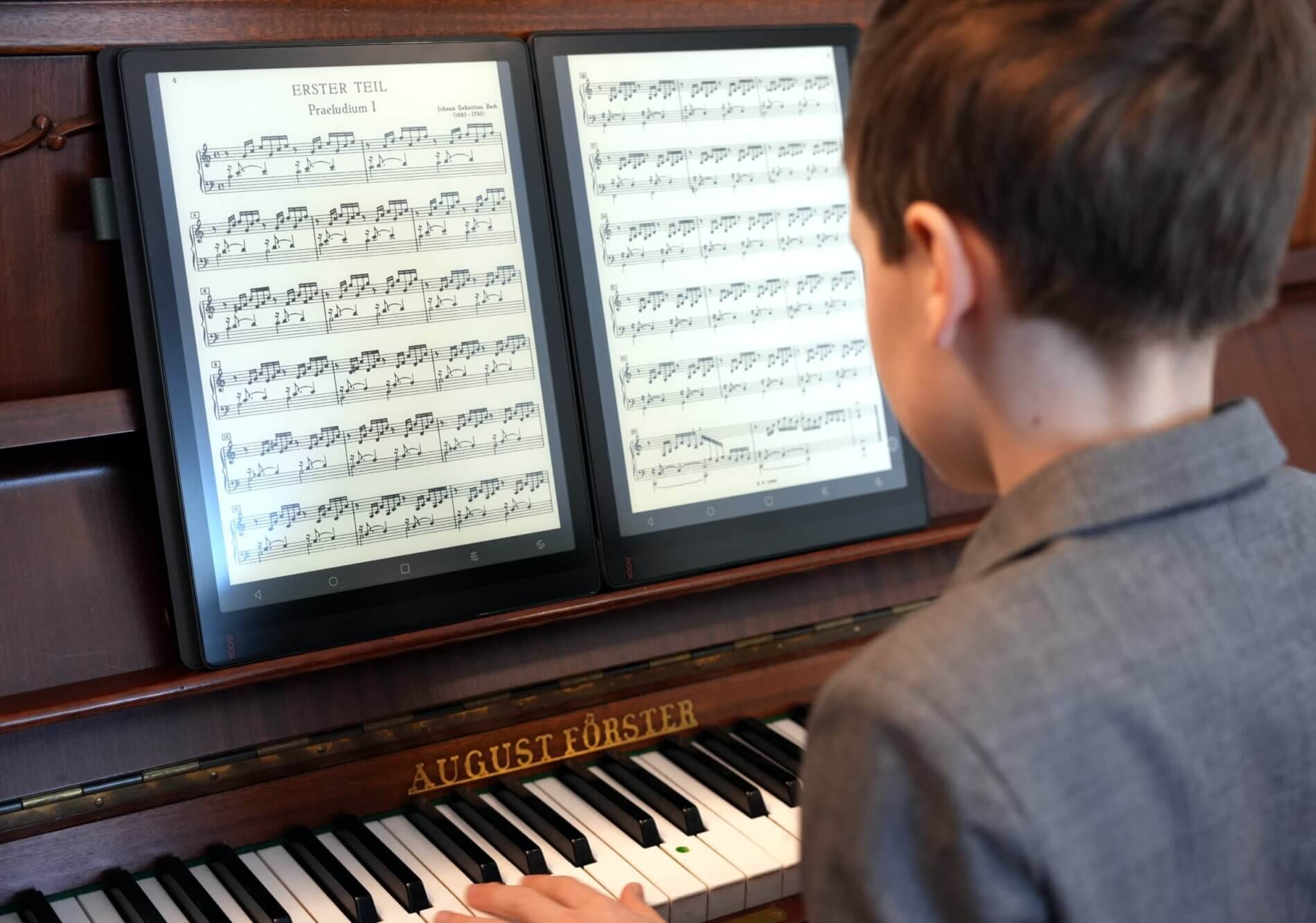
With two e-readers, piano practice gets a boost of motivation! Photo: tablets-for-musicians.com
Onyx Boox Tab X: Pros
- Large 13.3-inch screen
- Very thin (0.27 in) and light (1.23 lb)
- Large choice of apps
- Best large e-reader on the market
Cons
- Display lag (like all bigger e-readers) and poor reactivity
- No cellular option (Wi-Fi only)
- No camera (e.g., to scan sheet music)
- Very expensive
- Android 11 is outdated
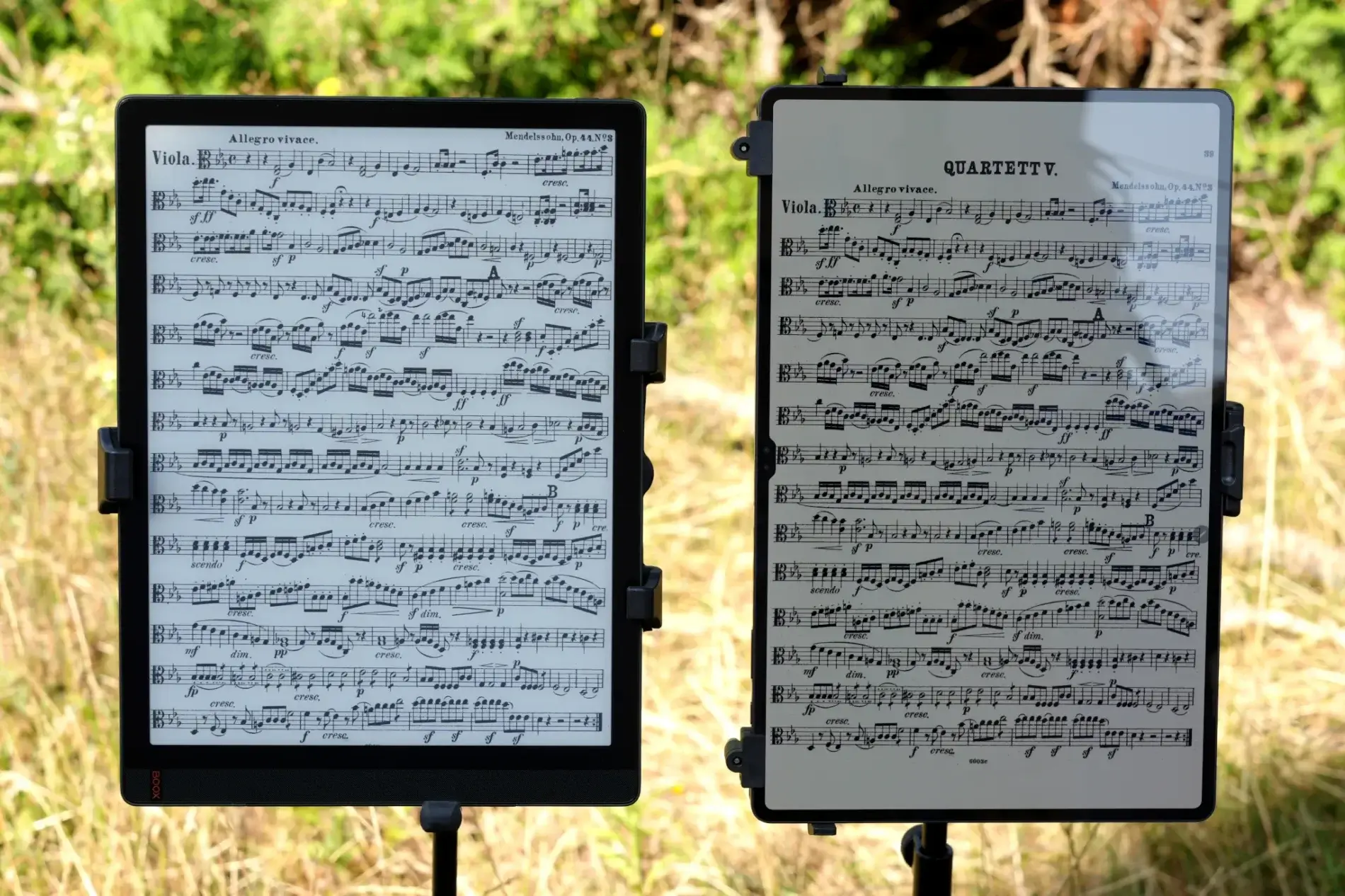
E-book-readers are much less prone to reflections and are easier to read outdoors than tablets. Here, an Onyx Boox Tab X vs. a Samsung Galaxy Tab S9 Ultra (right), unedited picture. Photo: tablets-for-musicians.com
Boox Tab X : Verdict
I have been using the Boox Tab X for several months for practice, in chamber music rehearsals and concerts. It is my device of choice for outdoor performances.
For typical use in music, I would recommend a 13-inch iPad Air or Pro or an Android tablet like the Samsung Galaxy Tab S9 or S10 Ultra. These tablets have cameras (for scanning sheet music), cellular options, and very responsive displays.
However, if you are bothered by glossy tablet displays, have a lot of outdoors gigs, or are looking for a more paper-like screen, the Boox Tab X is for you.
Which tablet holder / music stand can I use with the Boox Tab X?
The music stand I recommend for the Onyx Boox Tab X is the “K&M 19775 Biobased Tablet Holder”. It is the most universal high-quality stand available, it is compatible with the majority of large e-readers and tablets, with or without a protective case.
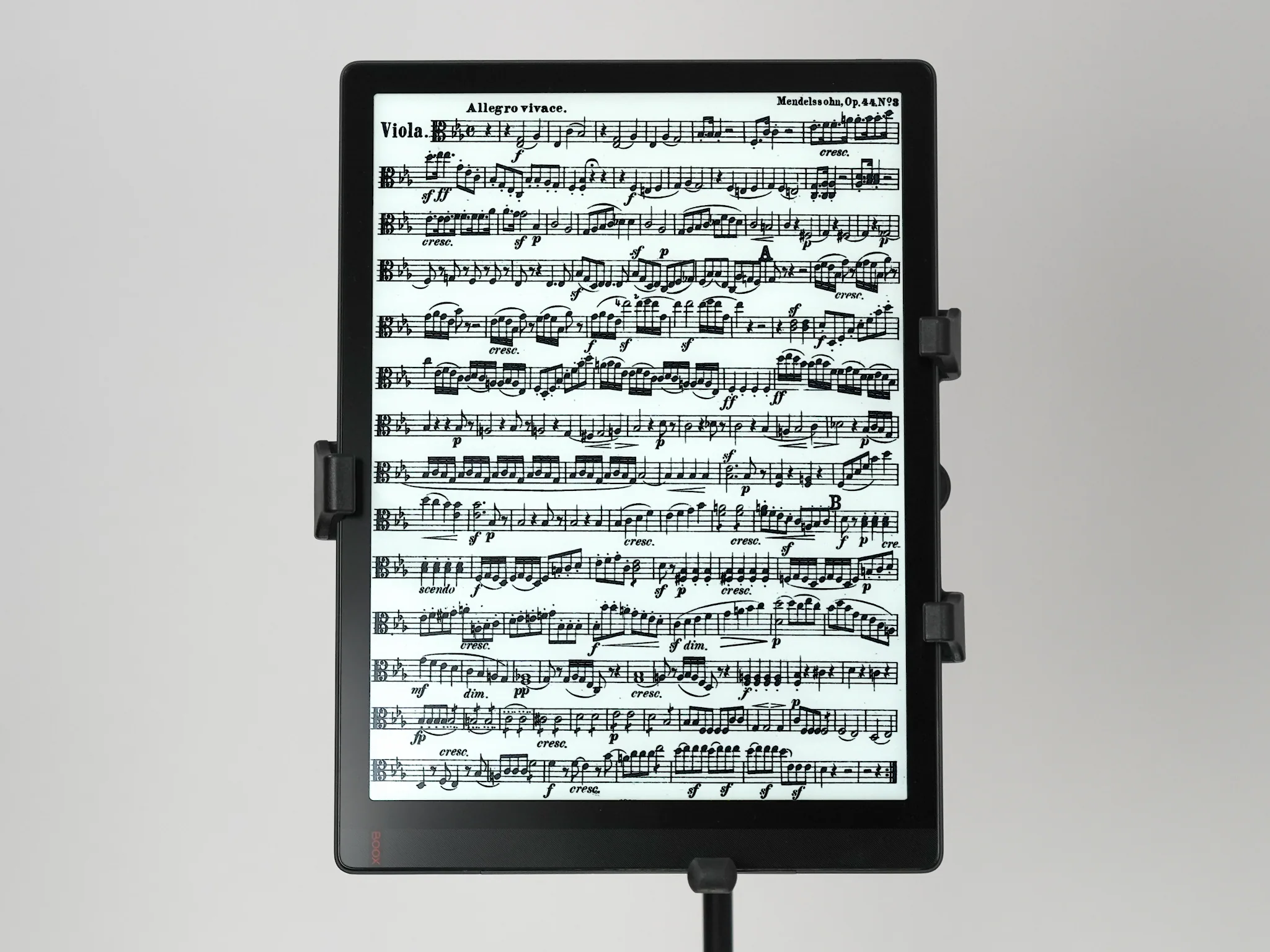
The best music stand for the Onyx Boox Tab X / PadMu 4 is the “K&M 19775 Biobased Tablet Holder”. Photo: tablets-for-musicians.com
In some photos on this page, you can see the Boox Tab X in the K&M 19793 “triangular” music stand. This is one of the most elegant music stands around, but the Tab X barely fits in it with the stand’s settings at maximum.
In addition, one of the arms which holds the corners of the e-reader protrudes (as seen in the photos), because the format of the e-reader is not really suited to this tablet holder. This is not my first choice, but it is a possible option, given the few compatible music stands.
2. PadMu 4
An excellent e-reader with an imperfect software suite
Take the best large-format e-reader on the market, the aforementioned Onyx Boox Tab X. Add a tailor-made software suite for reading sheet music.
Sprinkle generously with marketing aimed at musicians and ship worldwide via a pretty website: you get the PadMu 4.
This is the method used since 2016 by a small Italian company that has already convinced many musicians.
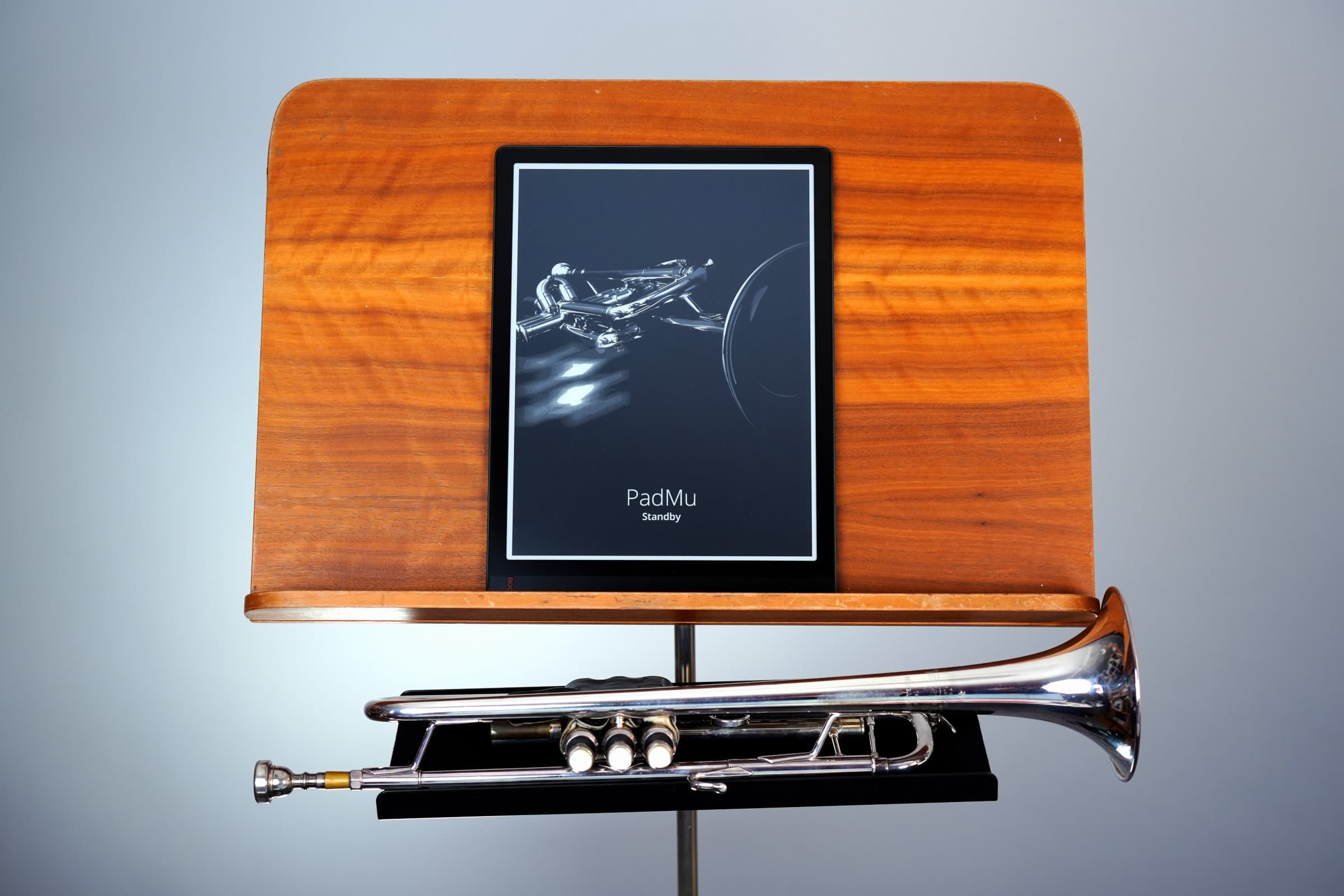
Although the PadMu 4’s software has major shortcomings, it is still an excellent e-reader. Photo: tablets-for-musicians.com
Unfortunately, the software suite that should make the PadMu 4 unique suffers from some major flaws. So much so that I can only advise you to install other applications to read and manage your sheet music.
However, when you use the PadMu with other apps, it’s just an Onyx Boox Tab X with a more musician-focused marketing strategy – and a lot more expensive. Nevertheless, it remains an excellent e-reader.
PadMu 4: Pros
- All-in-one solution specifically designed for musicians
- Well-thought-out and pleasant to use library
- Based on the best e-reader on the market
Cons
- Account required to use the PadMu applications
- Half-baked “PadMu Reader” sheet music reading app
- Poor page cropping function
- Can’t display two pages side by side in landscape mode
- Sluggish PadMu software suite
PadMu 4 – E-Reader for Musicians*
Please note: The PadMu 4 is not available on Amazon in the US and in Canada. The official PadMu website offers worldwide delivery.
3. Boox Note Max
An e-reader with many flaws, but with the best monochrome e-paper technology
In January 2025, two years after the Boox Tab X, Onyx has finally released its new 13.3-inch e-reader, the Boox Note Max. This is not the successor to the Tab X: it belongs to the “Note” series, one step down in the Boox product line.
The Boox Note Max features an E-Ink Carta 1300 screen, the best monochrome e-paper available. Its resolution is 3200 × 2400 pixels (300 PPI, compared to 207 PPI on the Tab X).
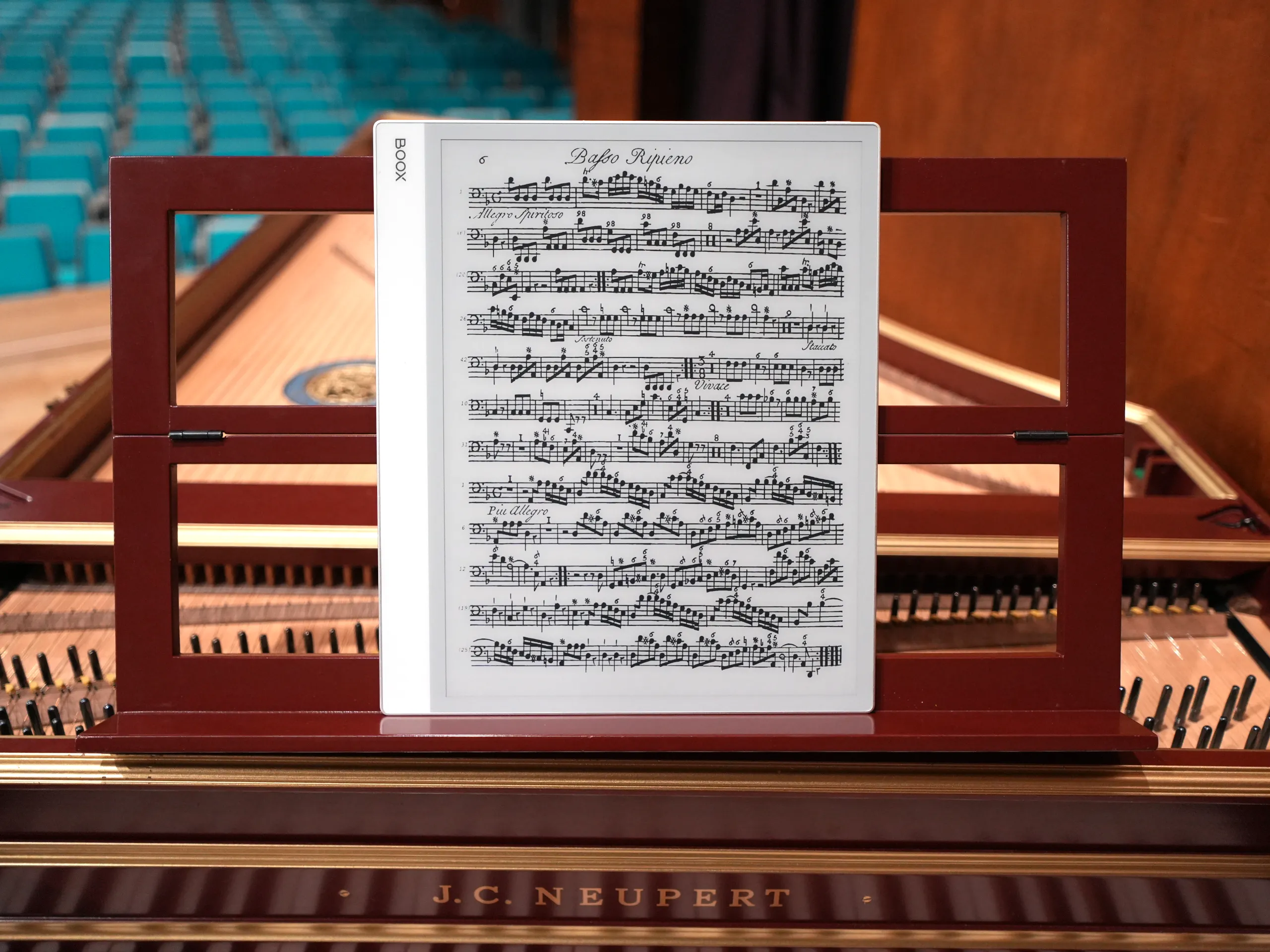
In good lighting, the Boox Note Max has an incredible display quality – if you are able to ignore the ghosting and gray background. Photo: tablets-for-musicians.com
The Note Max’s screen looks great, and reading music on it is a pleasure. Unfortunately, the background color is actually gray instead of white, which results in low contrast.
The Note Max’s biggest flaw is the lack of screen illumination. This makes it impossible to read in the dark or against the light. In low light, you’ll need to use a music stand lamp, just like you would with a paper score.
My full review of the Note Max will be out in a few weeks, with lots of photos and more details on battery life (disappointing), ghosting and the stylus.
Boox Note Max: Pros
- Amazing display (with good lighting)
- Best available black-and-white e-paper technology
- Ultra-wide viewing angles
- Super lightweight (21.7 oz / 615 g)
- Less expensive than the Tab X
Cons
- No backlight
- Unusable against the light
- Reflective screen, spreads and reflects light sources
- Strong ghosting
- Grayish background color
- Short battery life
4. What will be the successors to the Onyx Boox Tab X and the PadMu 4?
The Onyx Boox Tab X was released in January 2023, so it’s a relatively old device. The same goes for its version for musicians, the PadMu 4. However, electronic ink is not a technology that evolves quickly. The electronic paper market is dominated by the Taiwanese company E Ink. Its subsidiary Linfiny develops technical platforms for e-reader manufacturers.
The Boox Tab X and the PadMu 4 both feature the same E-Ink Carta 1250 screen, with a resolution of 2200×1650 pixels (207 PPI). The first large format e-reader to use this technology was the 2nd generation Fujitsu Quaderno, released in 2021 – that’s how dated the Carta 1250 e-paper is!
There is a more recent version of this technology, the E-Ink Carta 1300, but it is not currently marketed on 13.3-inch e-readers. And above all, the differences between Carta 1250 and 1300 are minor.
At the beginning of 2025, despite its age, the Boox Tab X remains the best large e-reader on the market, and no successor has yet been announced. And for musicians, there’s no PadMu 5 in sight either!
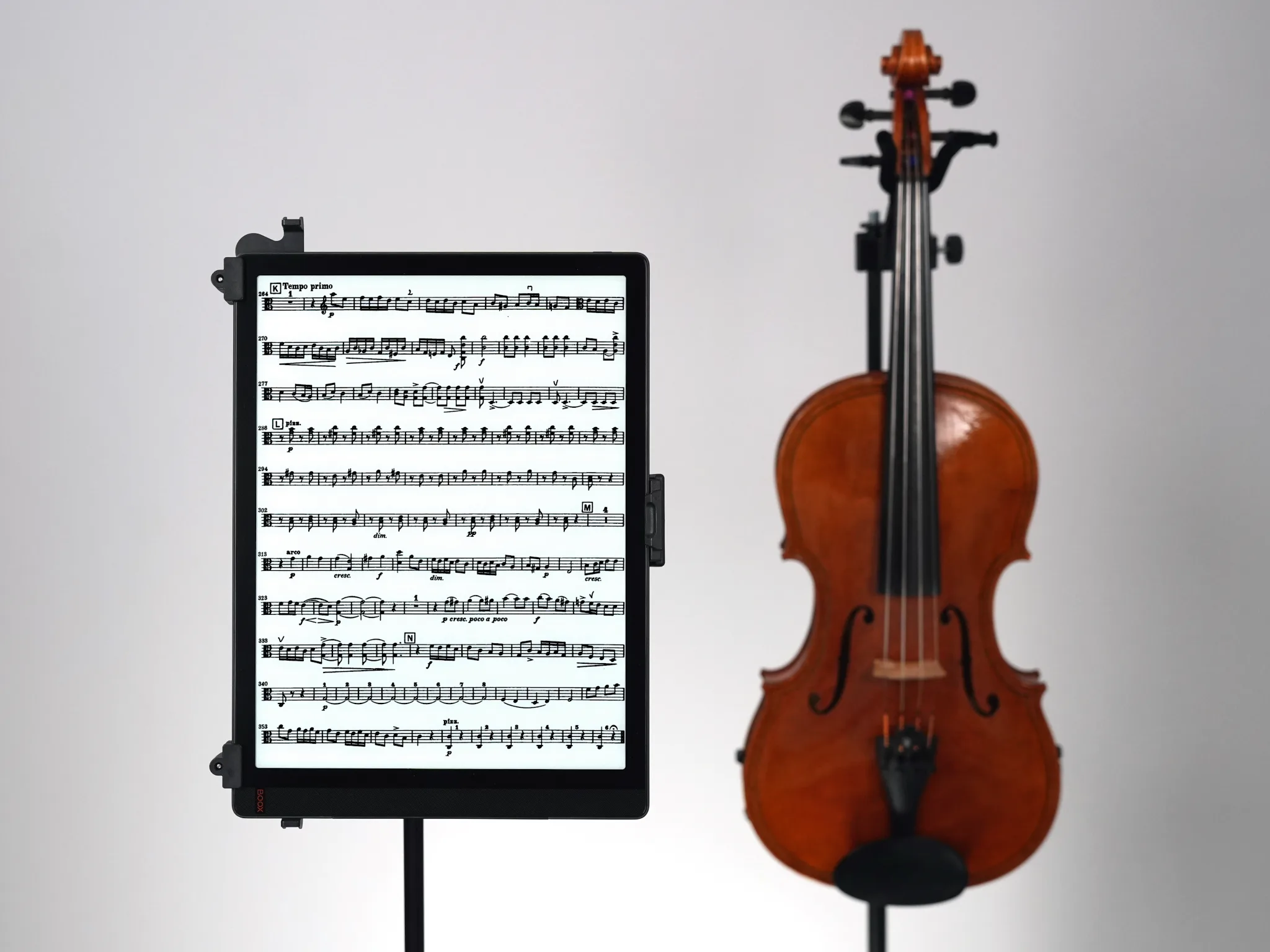
Despite its age, the Onyx Boox Tab X, released in early 2023, is still the best 13.3-inch e-reader. Photo: tablets-for-musicians.com
Will the successor to the Boox Tab X be in grayscale or color?
In April 2024, E Ink subsidiary Linfiny released a new technical platform for 13.3″ color e-readers.1 These e-readers feature a flexible Kaleido 3 screen with a resolution of 1650×2200 (206 PPI) when used in grayscale mode. They are also capable of displaying 4096 colors, but the resolution then drops to 825×1100 (103 PPI).
When it comes to displaying sheet music (in black and white or grayscale), there’s not much progress to be hoped for compared with the Carta 1250 technology of the Boox Tab X. Of course, it will be possible to annotate music scores in color, but with a 50% loss of resolution.
The first large e-reader based on Kaleido 3 e-paper is the Readmoo mooInk Pro 2C, released in May 2024 and aimed at the Asian market. It can be ordered as an import, but unfortunately, the interface is in Chinese, and there’s not even an English translation of the operating system and apps.
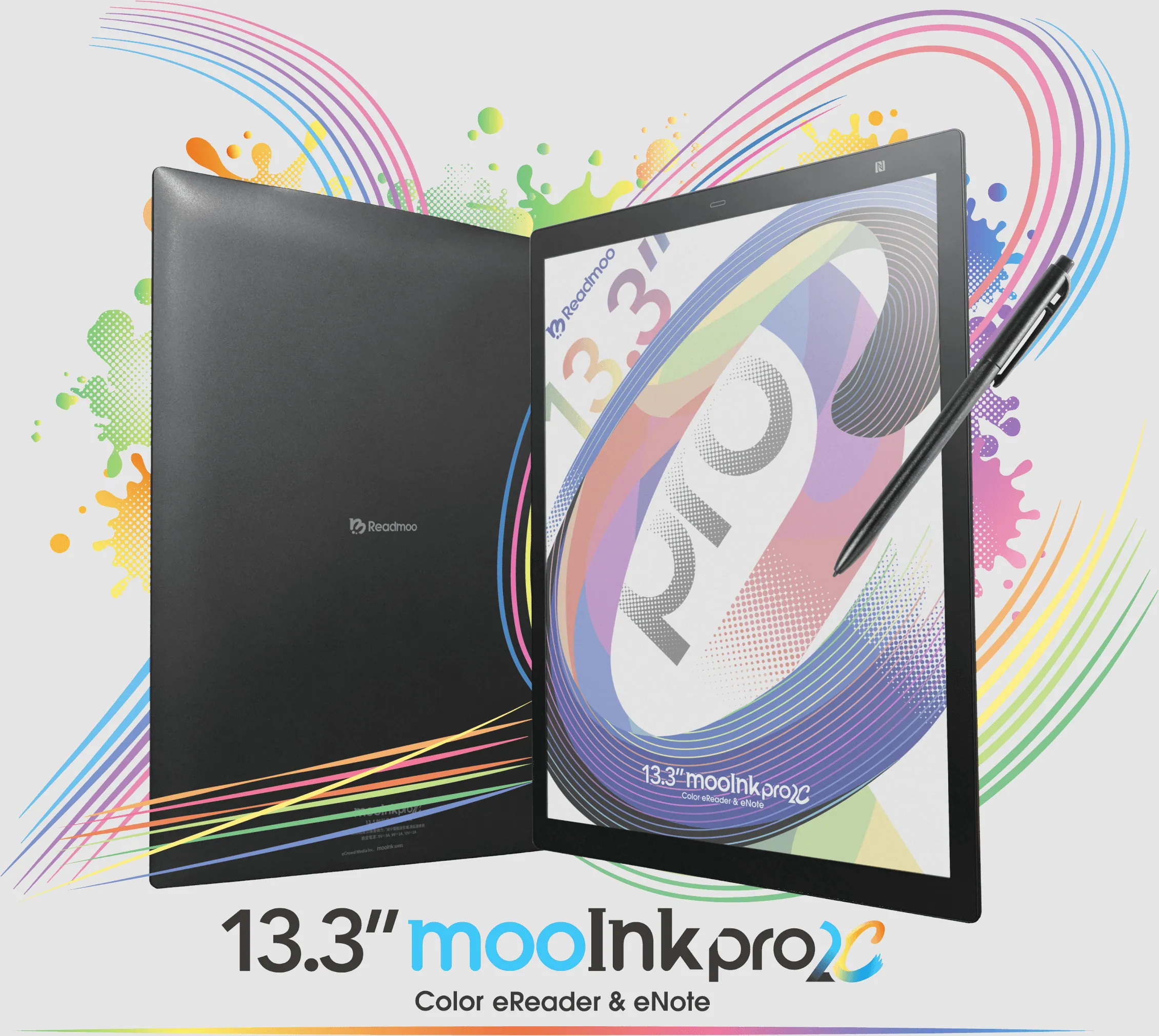
The trend is towards color e-ink displays. The Readmoo mooInk Pro 2C is the first large e-reader using Kaleido 3 E-Ink technology. It is not available in English. Picture: Readmoo
Other e-reader manufacturers (Onyx Boox, Dasung, Bigme, Hanvon) will probably release tablets based on this platform in the first half of 2025.
My personal prediction is that the successor to the Boox Tab X will be based on Kaleido 3 color screen technology rather than the monochrome Carta 1300. Its name will probably be suffixed with “C” and could be “Onyx Boox Tab X C”.
Ideally, Onyx Boox will release a new monochrome version (the Boox Tab X II?) alongside the color version, with updated technical and software specifications (an upgrade to a more recent version of Android).
In any case, there’s (unfortunately) no huge progress to be expected from these new versions in terms of e-paper quality.
E-readers and music: frequently asked questions
No, e-book-readers with 13.3″ screens are the largest available on the market.
There are, however, larger tablets:
- The Samsung Galaxy Tab Ultra with a 14.6-inch screen. There are three generations: the S8 (launched in 2022), the S9 (2023) and the S10 (2024).
- The Lenovo Tab Extreme with a 14.5-inch screen.
These are high-end Android tablets with a 16:10 aspect ratio.
No, there is no e-reader from Apple, and no model is planned.
Music Education and E-readers
For teachers
For those old-school music teachers who only want to take notes and read sheet music (or books), an e-reader can be the perfect tool. For note-taking, the Play Store allows you to install One Note, Evernote or Google Keep, to name a few.
Keep in mind that e-ink screens are not made for dynamic, colorful or interactive applications, such as TuneKey, Complete Rhythm Trainer or Music Speed Changer.
For kids
E-readers have the “advantage” over tablets of being fairly unusable with applications such as YouTube, TikTok, or Instagram. Focusing on the voice or the instrument is probably easier when practicing with an e-reader than with a tablet.
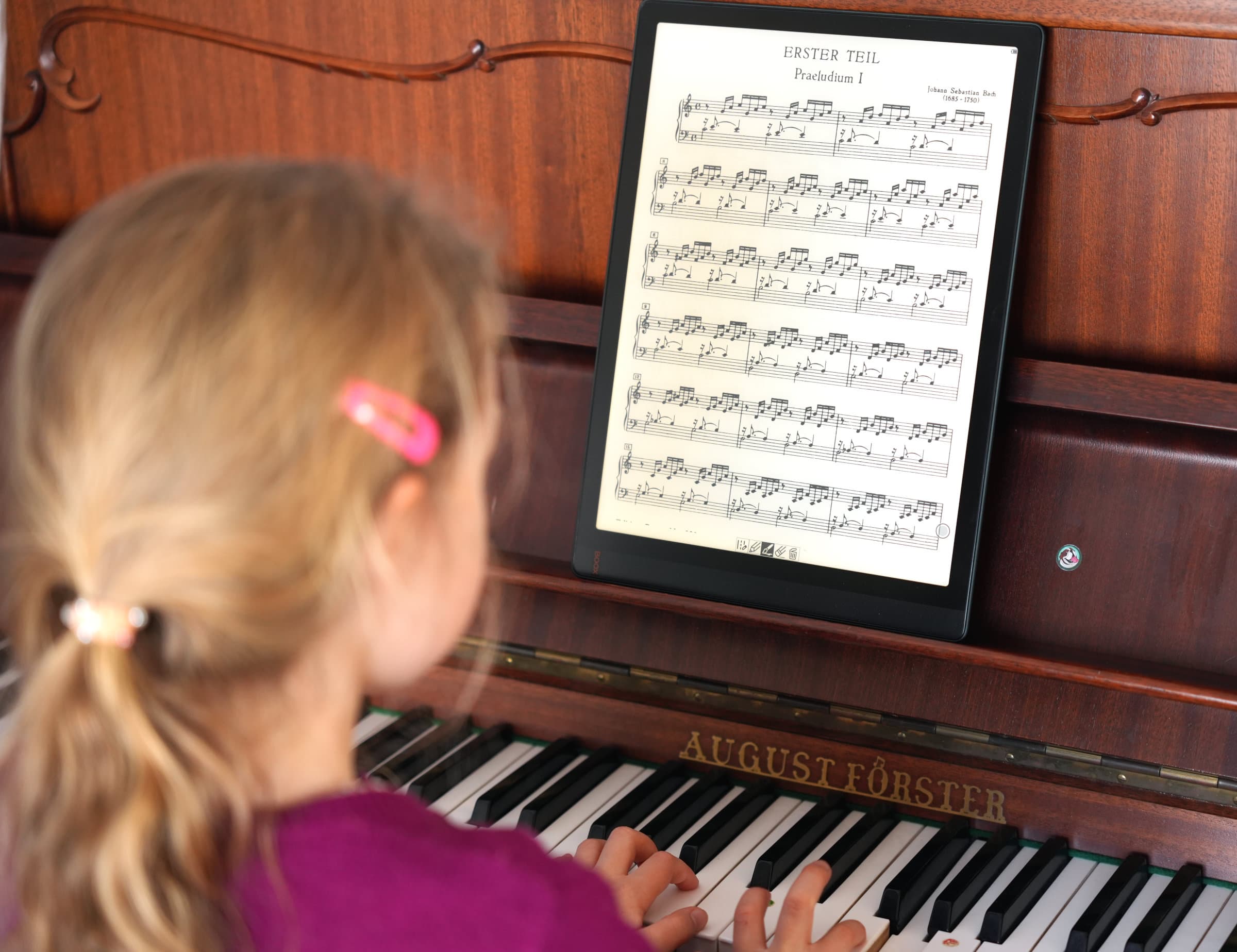
A piano lesson with an e-reader (completely simulated, my daughter having been kind enough to pose for the picture). Photo: tablets-for-musicians.com
For music students
An e-reader can be a great tool for music students to stay focused to study effectively. The appeal of YouTube, Instagram, or games is greatly diminished compared to a tablet. Other advantages include lightness (three to six times lighter than a laptop) and the convenience of taking notes on electronic paper.
For the self-taught
For autodidacts, especially beginners, an e-reader is probably not the best choice. Instrument-learning apps like Simply Piano and Flowkey for pianists, Yousician for guitarists, or various music theory apps (like Complete Music Reading Trainer) work best on tablets.
Musicians should avoid these e-readers
Fujitsu Quaderno e-readers
The first generation of Fujitsu Quaderno e-readers was released in 2019, with two variants corresponding to the A5 and A4 paper sizes. (These paper formats are used worldwide, except for North America and parts of Central and South America). The Quaderno A4 is one of the few e-readers to have the size required to display sheet music.
In 2021, Fujitsu released the second generation of its Quaderno e-readers, updating the electronic paper to the best version at the time, the “E Ink Carta 1250”.
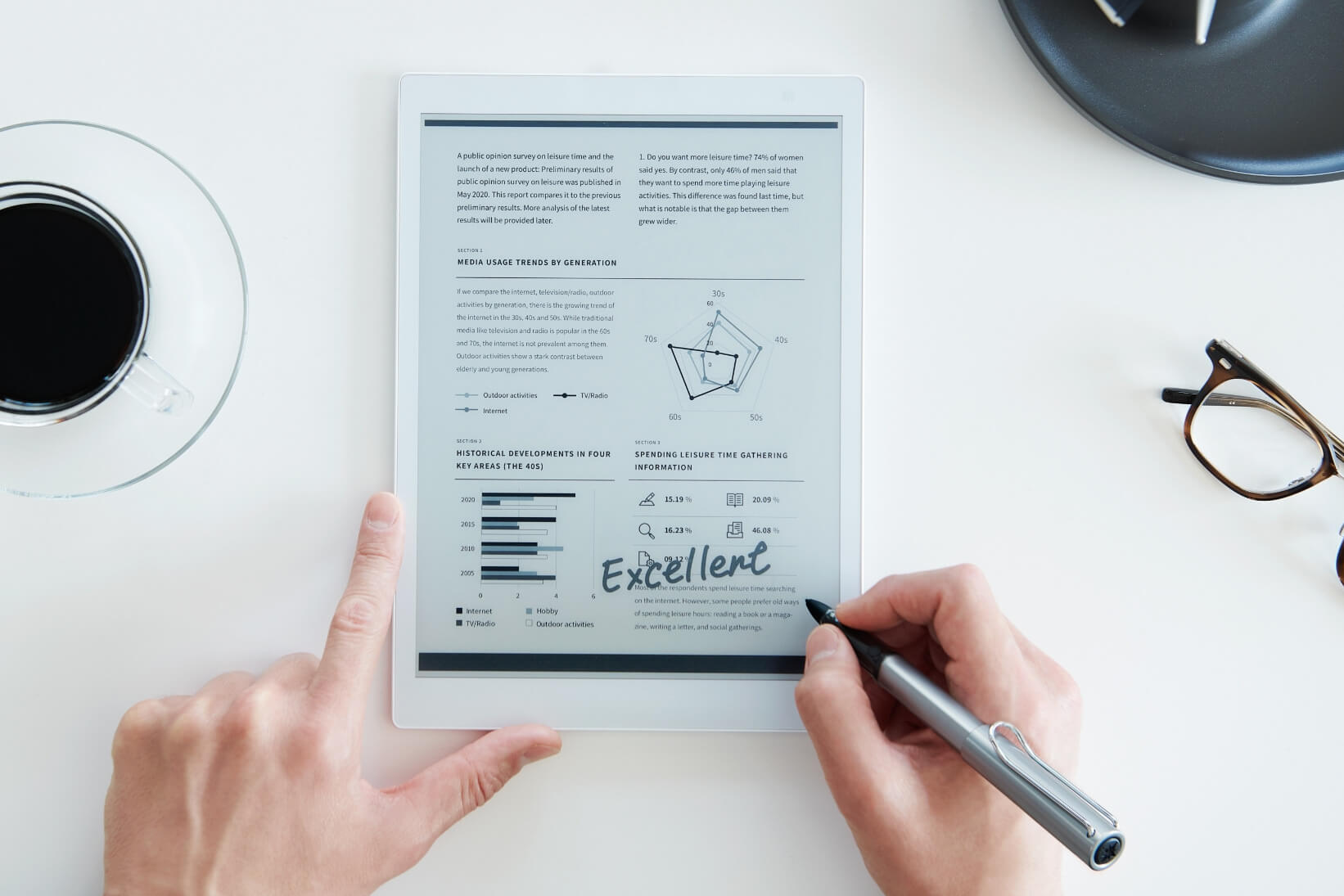
The Fujitsu Quaderno A4 is primarily designed for the Japanese market (picture of the 2nd gen Quaderno). Photo: Fujitsu Quaderno
A 3rd generation constantly pushed back, but finally “available”
The third-generation “Fujitsu Quaderno” A4 and A5 e-readers upgraded with the new Kaleido 3 electronic ink were expected in 2023. At the end of that same year, it seemed that the very future of the Quaderno line was uncertain.2
Finally, several years late, the 3rd generation Quaderno was announced in early 2025. It remains aimed at the Japanese market, but can be imported via the Fujitsu Quaderno Store, a front-end to the renowned Good E-Reader website.
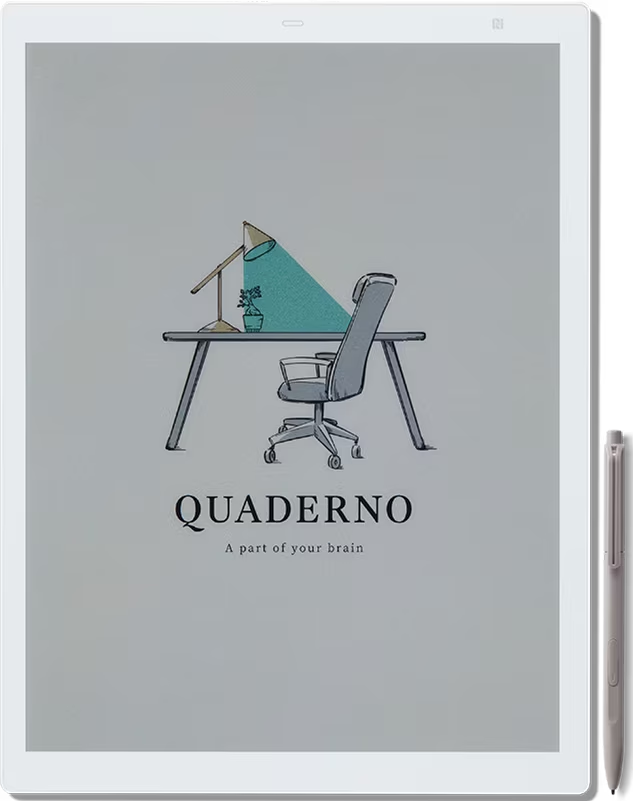
Third-generation Fujitsu Quaderno e-readers have color screens. Picture: Fujitsu Quaderno
The Quaderno A4 Color has a 13.3-inch Kaleido 3 flexible screen with a monochrome resolution of 1650 × 2200 (207 DPI). This is a lower resolution than black and white readers based on Carta 1300 technology, which achieve 300 DPI.
The Quaderno A4C can display 4096 colors, but the color resolution drops to 103 DPI. As usual with color readers, the number of colors available for writing or annotating (text or sheet music) is limited, Fujitsu has chosen eight colors.
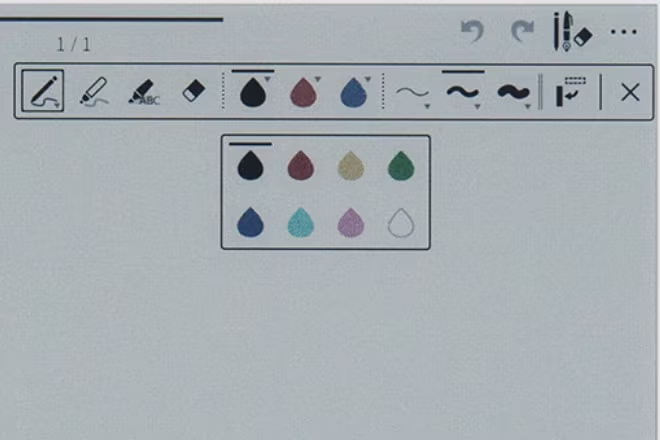
User-available colors on 3rd generation Quaderno. Screenshot: Fujitsu Quaderno
Fujitsu Quaderno e-readers run Android, but without access to the Play Store. This means that the most popular score-reading apps such as MobileSheets, MuseScore or IMSLP cannot be easily installed.
Quaderno e-readers come with a stylus and support for Bluetooth pedals. They can theoretically be used to read sheet music, but their limited availability in much of the world makes them difficult to recommend (outside of Japan).
The reMarkable Paper Pro: An awesome e-reader, unfortunately without Bluetooth support
The reMarkable Paper Pro, released in September 2024, is the first e-reader featuring a large 11.8-inch color display. This screen size is unusual, and lies halfway between the large 13.3-inch e-readers and the 10.3-inch e-readers, with the latter being closer to half-letter (or A5) paper size.
At 71% of the size of a sheet of Letter paper (69% of the size of a sheet of A4 paper), the reMarkable Paper Pro is, in my opinion, too small to read scores comfortably. However, it’s certainly possible to use it occasionally, especially for instruments where the player is physically close to the score, such as piano or voice.
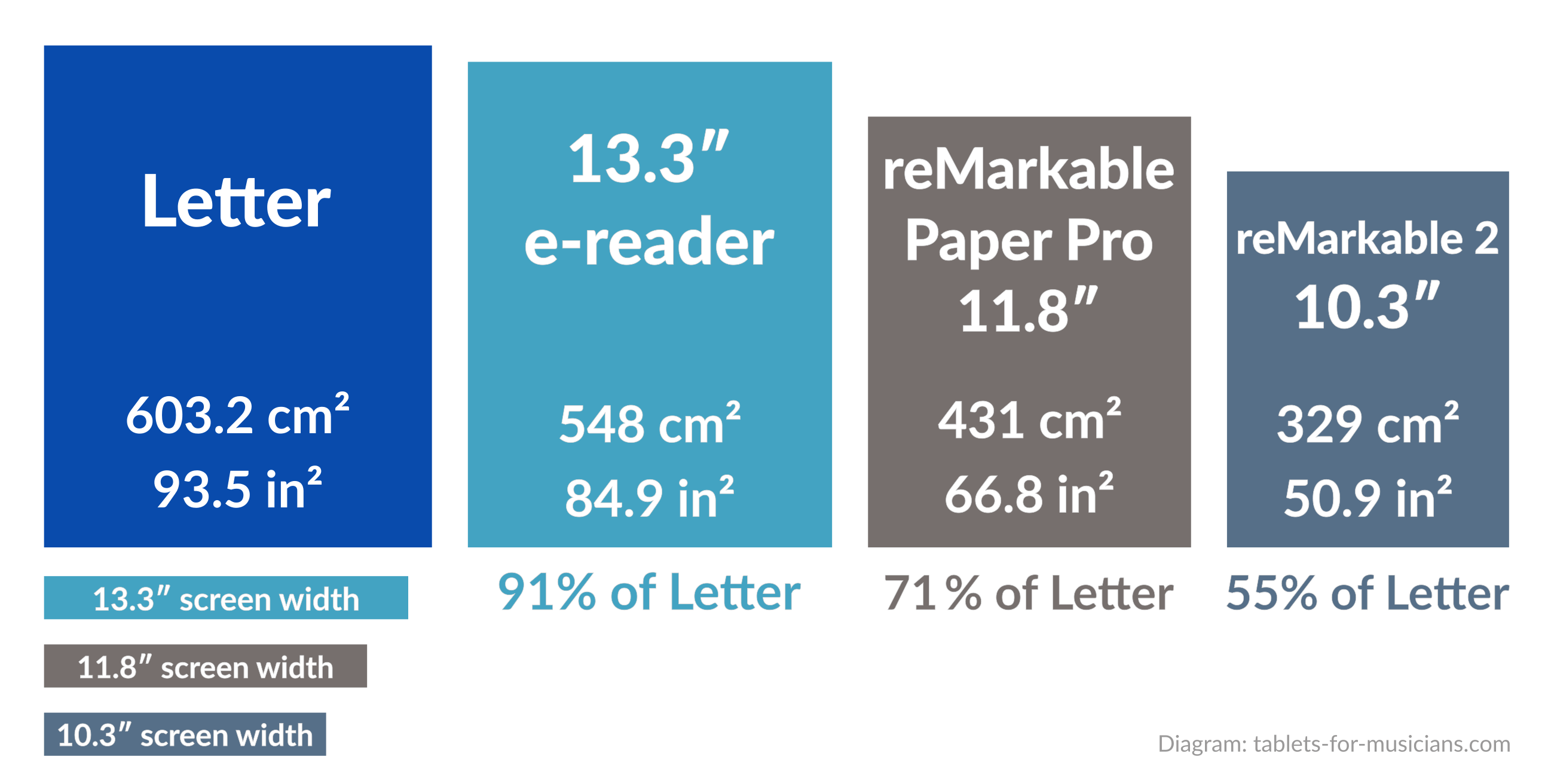
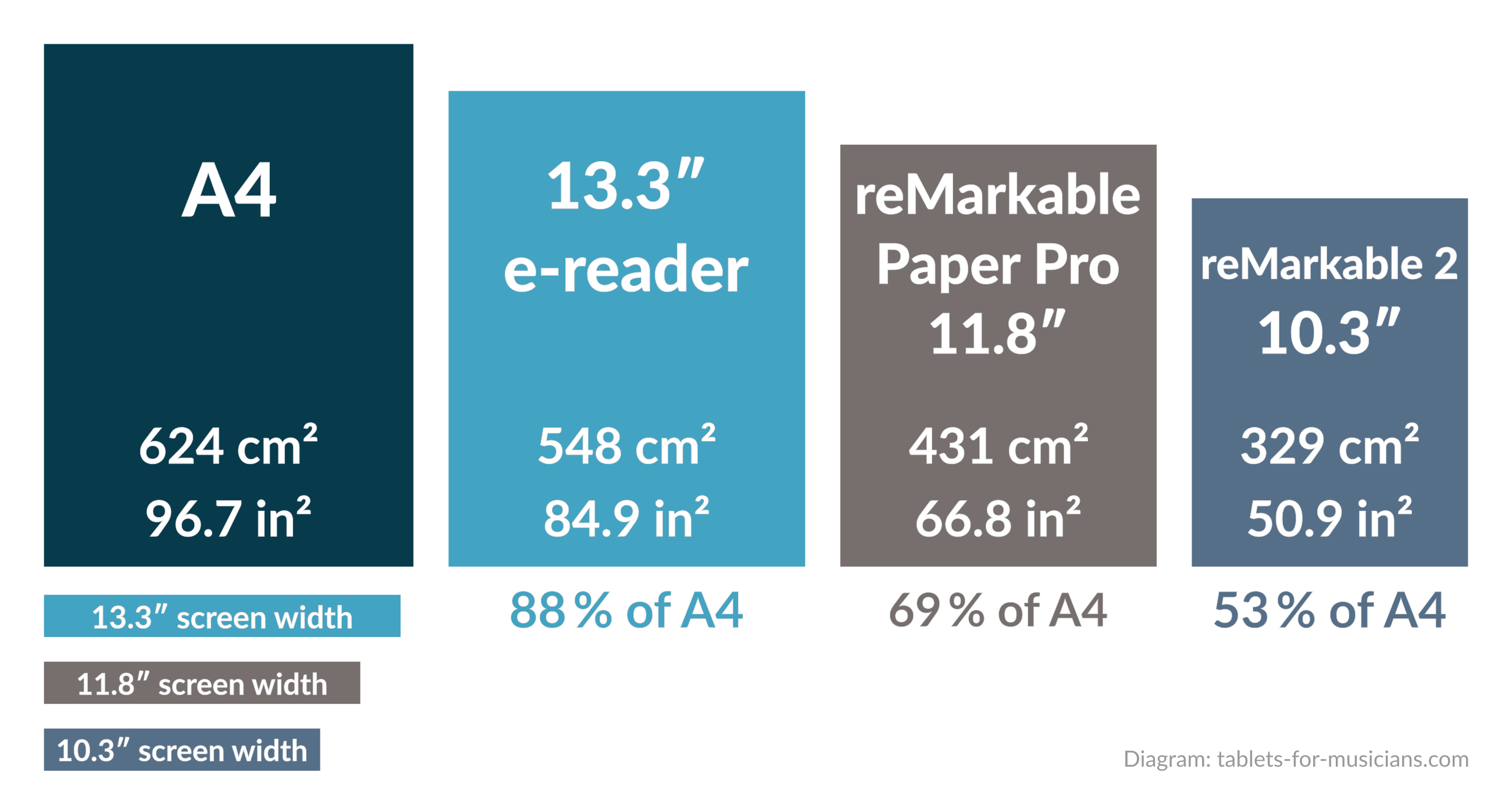
The screen of the reMarkable Paper Pro is roughly two-thirds the size of a sheet of paper.
The reMarkable Paper Pro’s color E Ink display uses E Ink’s “Gallery 3” technology. It is the first large-format e-book reader with this technology available outside of Asia. Colors appear more natural and less washed out with Gallery 3 than with Kaleido 3 technology, but the screen refresh rate is significantly slower.
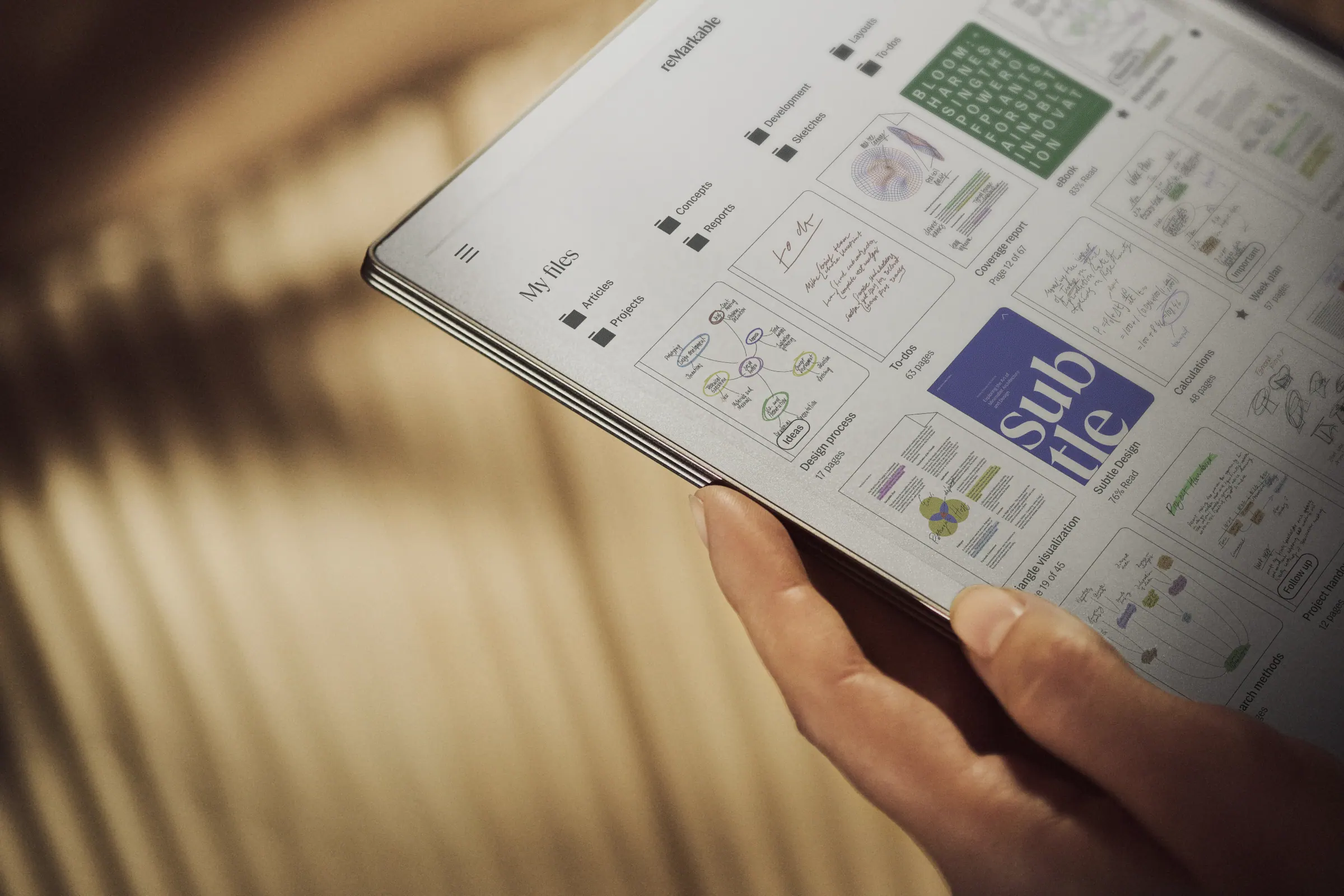
The reMarkable Paper Pro, one of the few e-readers with a large screen and color e-ink display, is not compatible with Bluetooth page turners. Photo: reMarkable
I would have loved to test the reMarkable Paper Pro for reading sheet music, but it lacks two essential features:
- Like all reMarkable e-readers, it doesn’t support Bluetooth. So there’s no way to connect a foot pedal to turn pages, or to use a keyboard other than the (expensive) official “Type Folio” keyboard.
- Due to the closed operating system, there is no access to sheet music reading apps, neither via an app store nor via APK packages.
The reMarkable Paper Pro might be suitable for singers, especially choristers, as they usually don’t need a page-turning pedal. It also weighs only 525 g (1.16 lb), making it easy to hold during long rehearsals.
E-readers designed for the Asian market
There are two further e-readers whose size is suitable for reading sheet music. Unfortunately, these are not intended for the American or even global market. These are the following models:
- The Dasung Not-eReader 133 (sic) is equipped with a 13.3-inch Carta 1250 e-ink display with a resolution of 2200 × 1650 pixels, a Qualcomm Snapdragon 660 processor and 4 GB of RAM. Despite its recent release (late 2023), it runs Android 9, a completely outdated version, which makes it difficult to recommend.
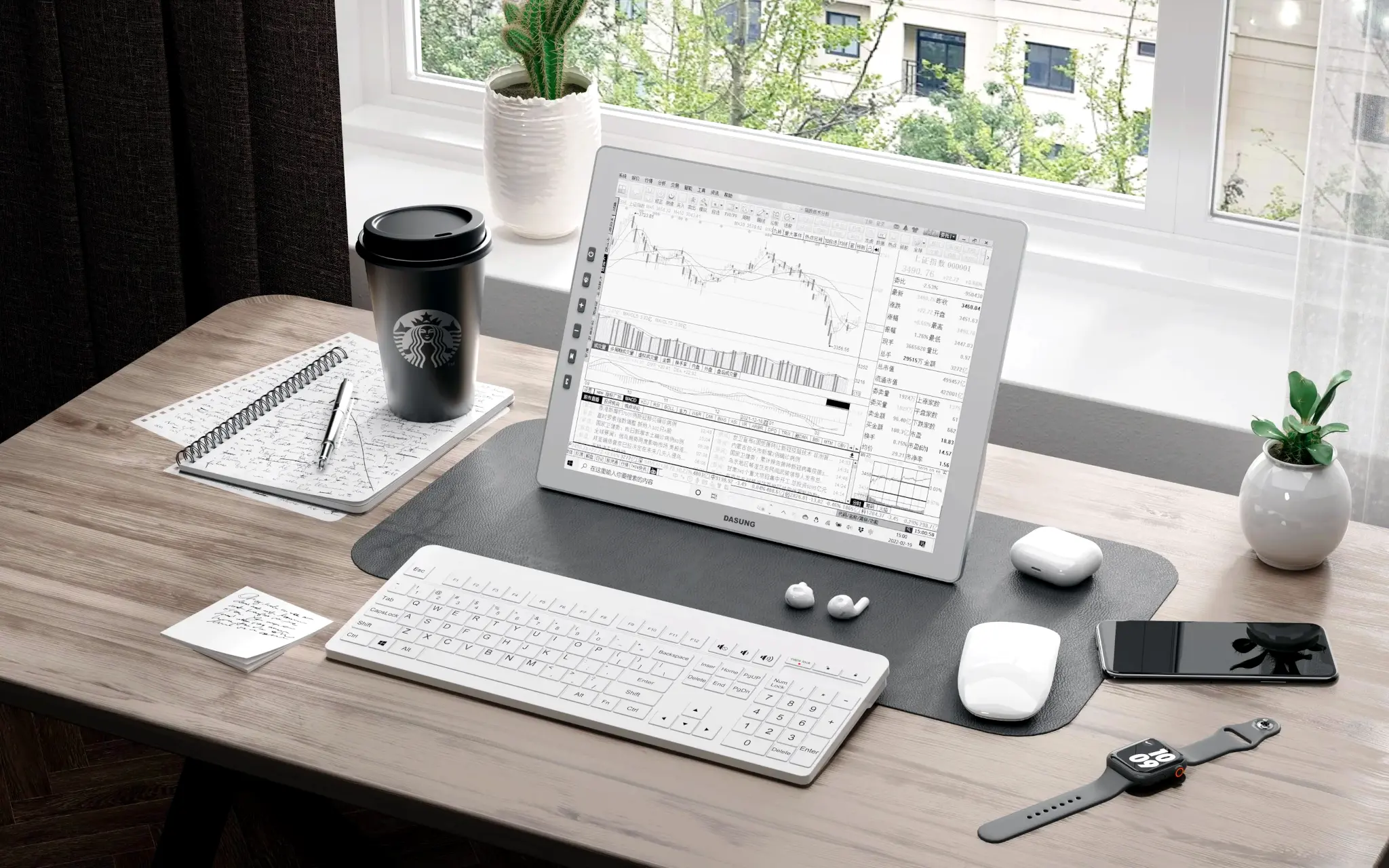
The Dasung Not-e-Reader 133 is aimed at the Chinese market. Photo: Dasung
- The Hanvon N10 Max 2024 is also equipped with a 13.3-inch display manufactured by Linfiny. While it runs a less outdated Android 11 version, its processor (the Rockchip RK3566) is the same as in the Lenovo Smart Paper. This is not good news, since it struggles to run even the simplest applications.
Even though their e-ink screens are excellent, these two e-readers fall far short of the Boox Tab X in terms of performance, software support, and adaptation to the global market. Musicians, move on!
E-readers too small to read sheet music
The reMarkable 2: not a good option for musicians
The reMarkable 2 is a beautiful e-reader with a two-week battery life. Presented as “the thinnest tablet in the world” (0.19 in), it is also very light (0.89 lb).
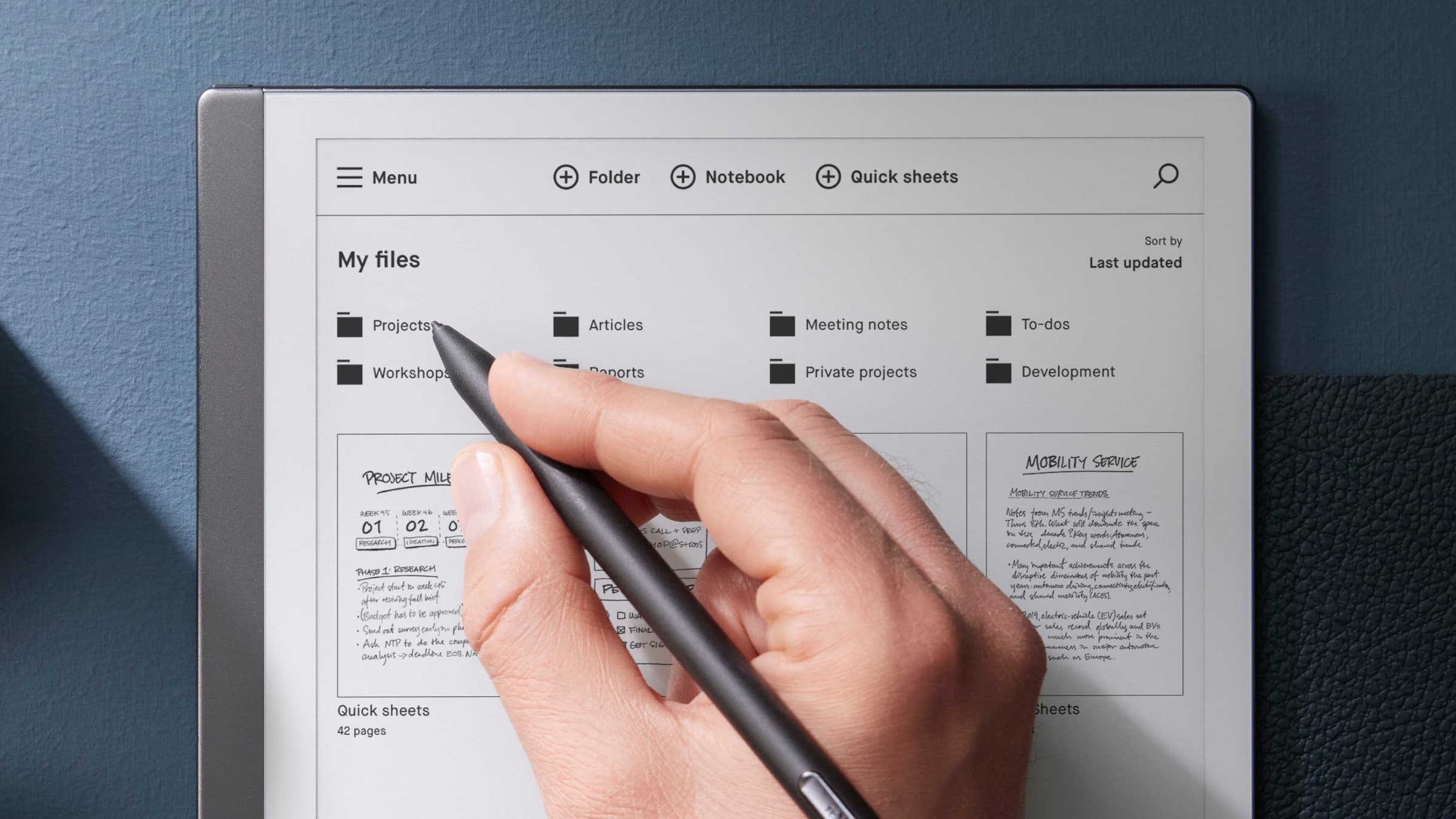
The reMarkable 2 is a fantastic tablet, but not for musicians. Photo: reMarkable
Unfortunately, the reMarkable 2 does not run on iOS or Android. It is limited in terms of apps: forScore, MuseScore or MobileSheets are not available, nor any other music production or notation software.
Another dealbreaker is the lack of Bluetooth support, a real problem for connecting a foot pedal / page turner. This makes the ReMarkable 2 useless for almost all performing musicians.
Is the Lenovo Smart Paper a good tablet for musicians?
Unlike the reMarkable 2, the Lenovo Smart Paper has Bluetooth 5.2 support and runs on Android 11. It has a 10.3-inch E INK Carta HD e-paper screen with a resolution of 2000 x 1200 pixel (212 PPI).
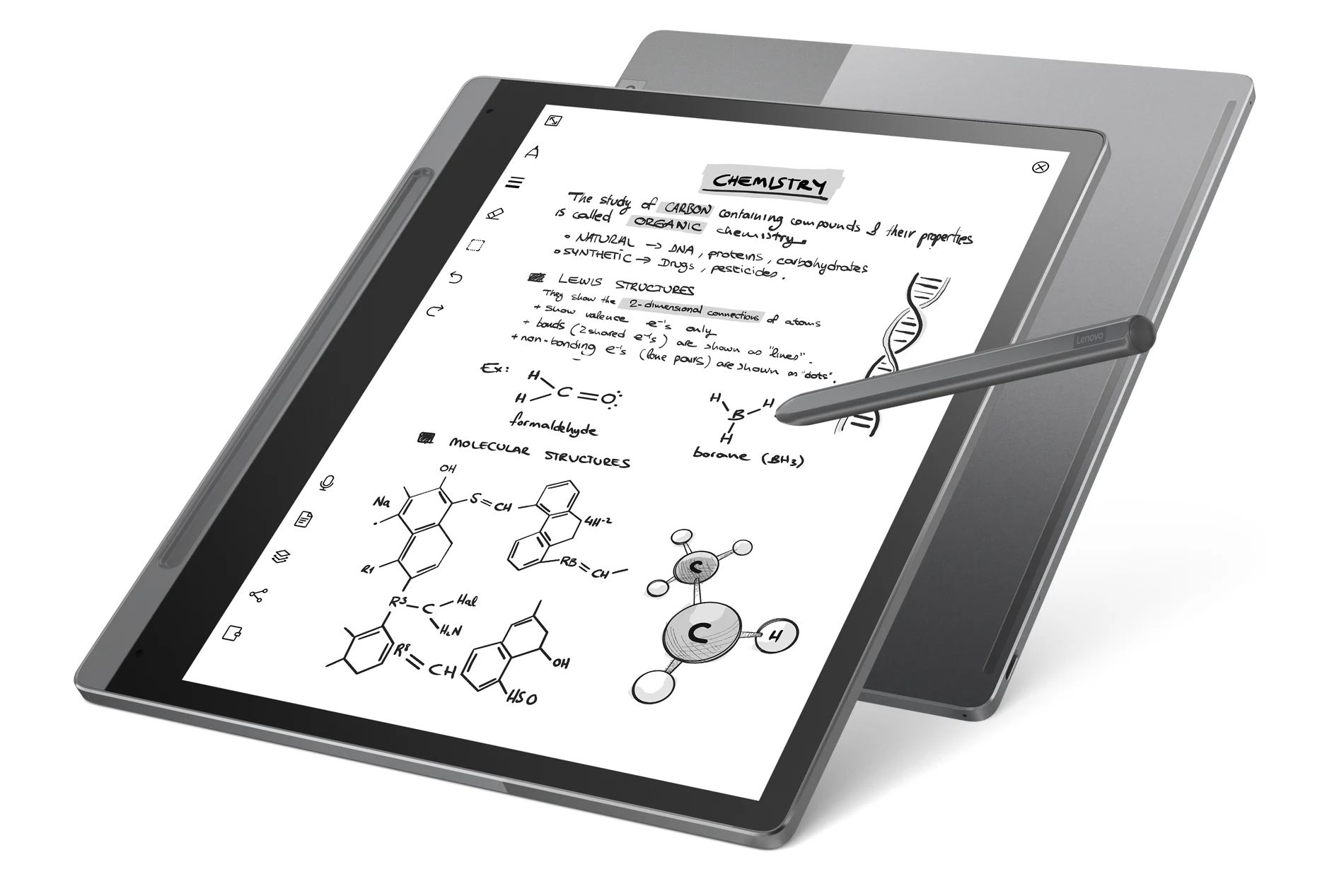
The Lenovo Smart Paper is too small for reading sheet music. Photo: Lenovo
The Smart Paper is potentially a usable tablet for musicians, but its small screen may be too small to comfortably view and interact with sheet music, especially for longer rehearsals or practice days.
Overall, the Lenovo Smart Paper may be a good option for musicians with good eyes and fans of E Ink technology, but it may not be the best choice for those who need a larger screen for reading sheet music.
PadMu 4 – E-Reader for Musicians*
Please note: The PadMu 4 is not available on Amazon in the US and in Canada. The official PadMu website offers worldwide delivery.
- Good E-Reader, Linfiny is releasing their Digital Paper Color 13.3 e-note in 2024, April 29, 2024
- Good E-reader, The Fujitsu Quaderno is at a crossroads, October 18, 2023

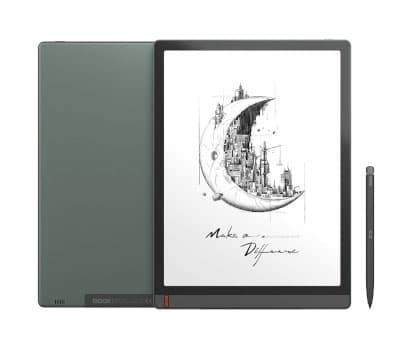
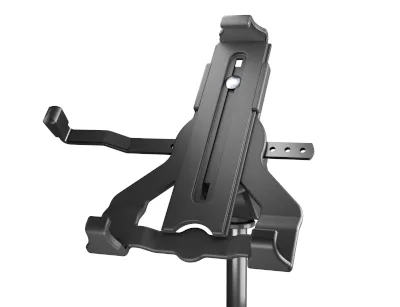
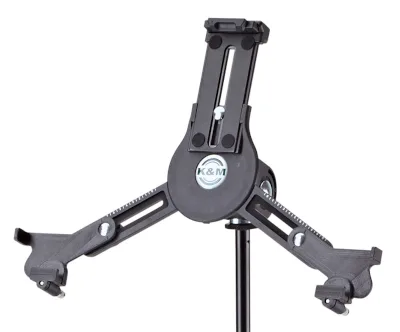
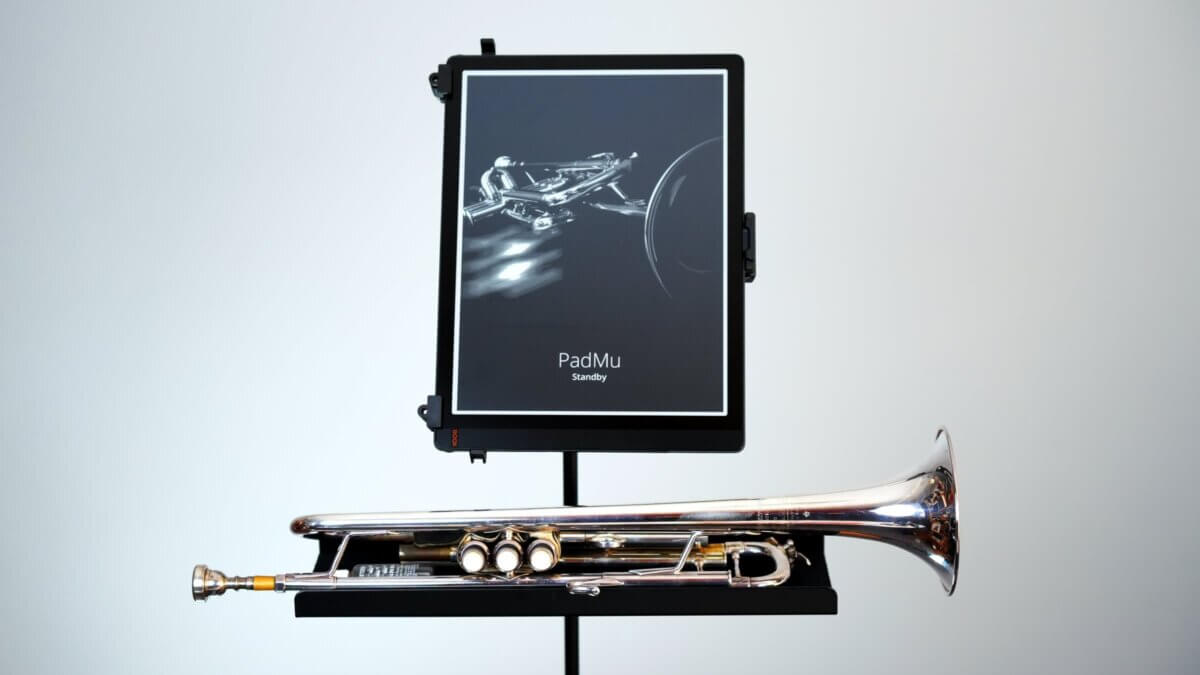
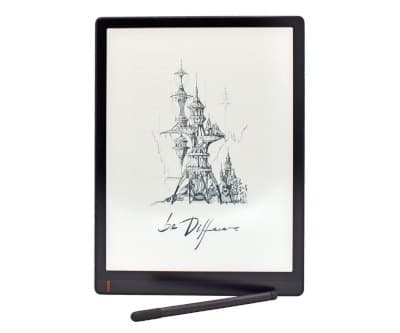
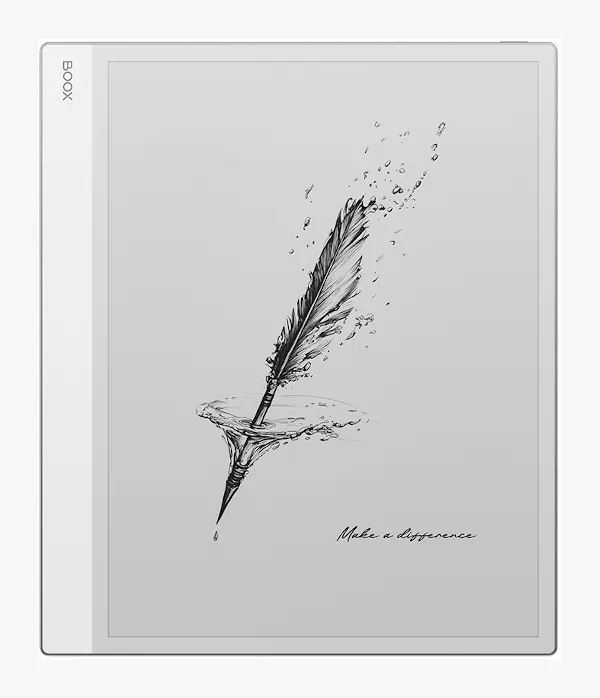
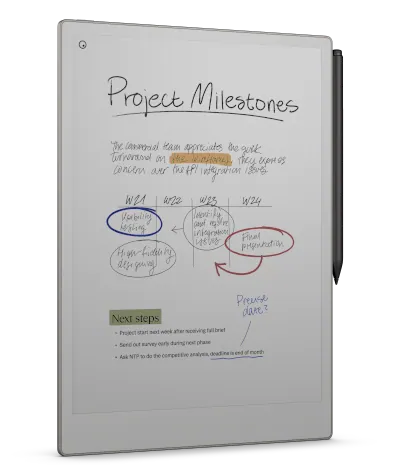
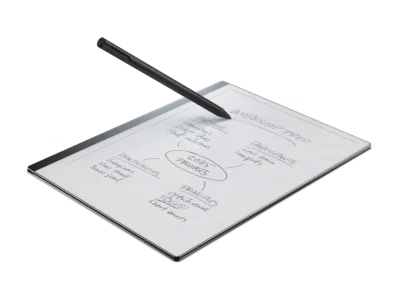
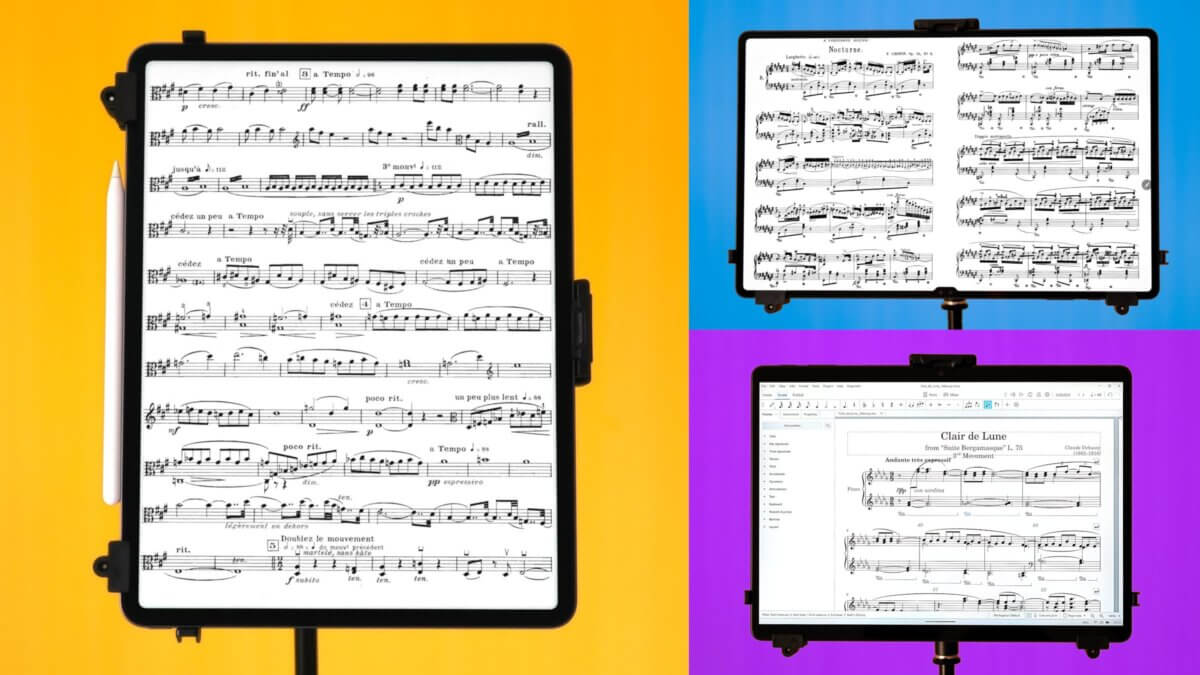
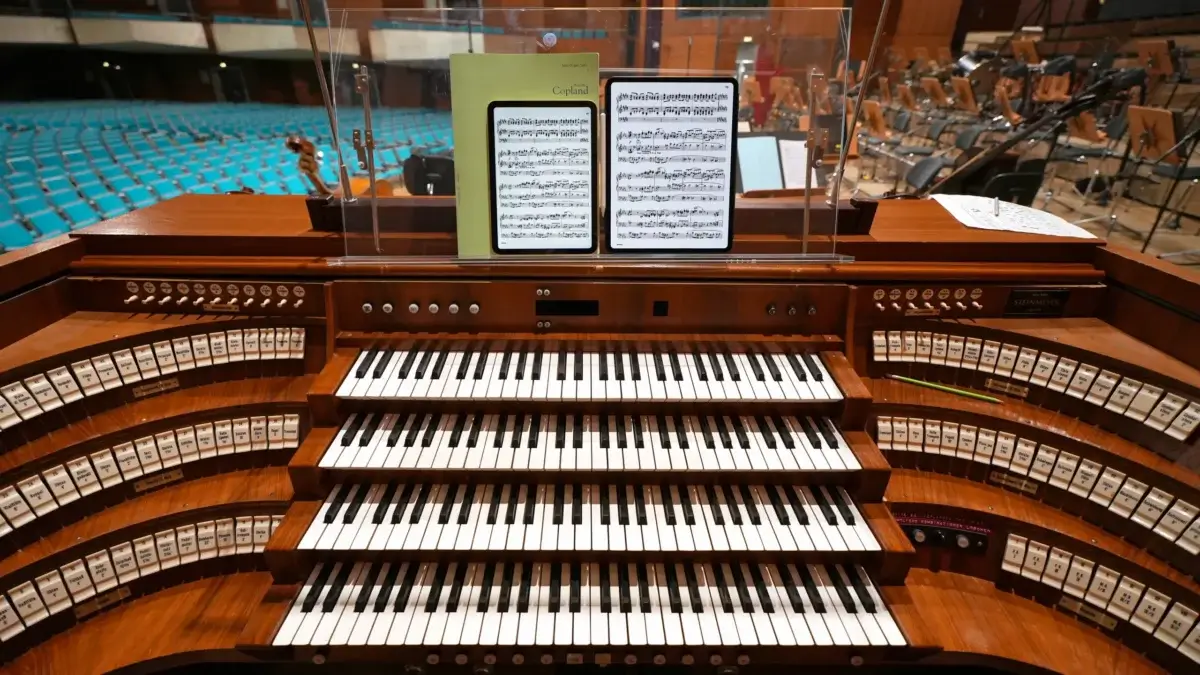
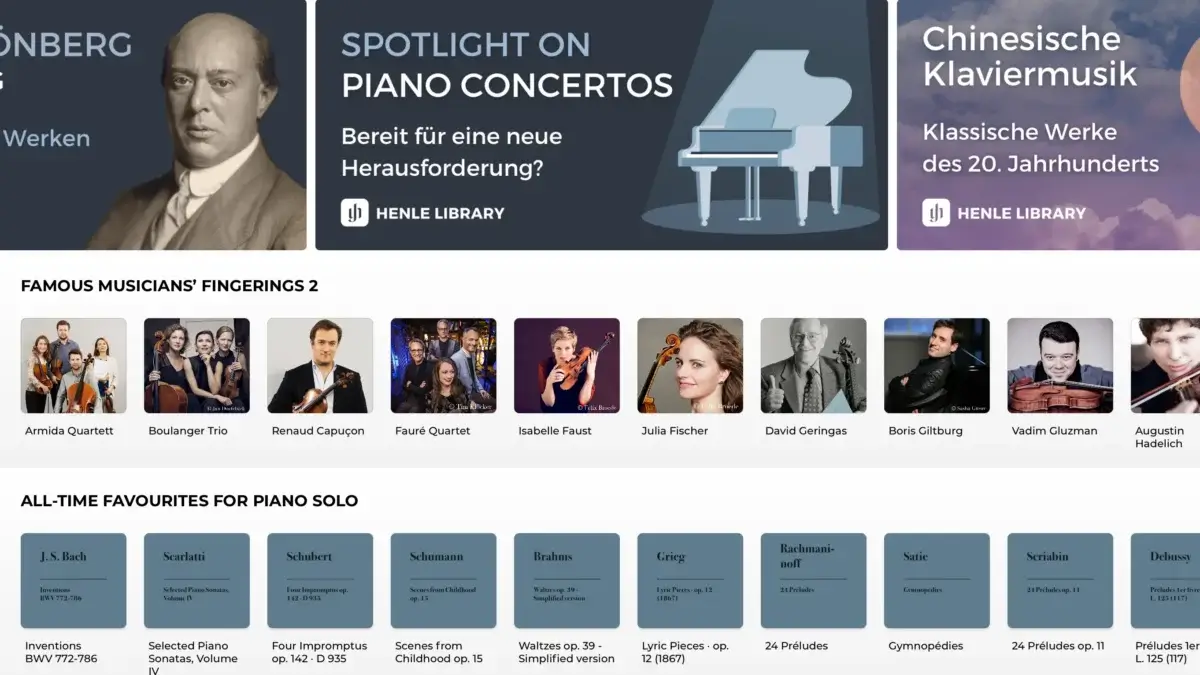
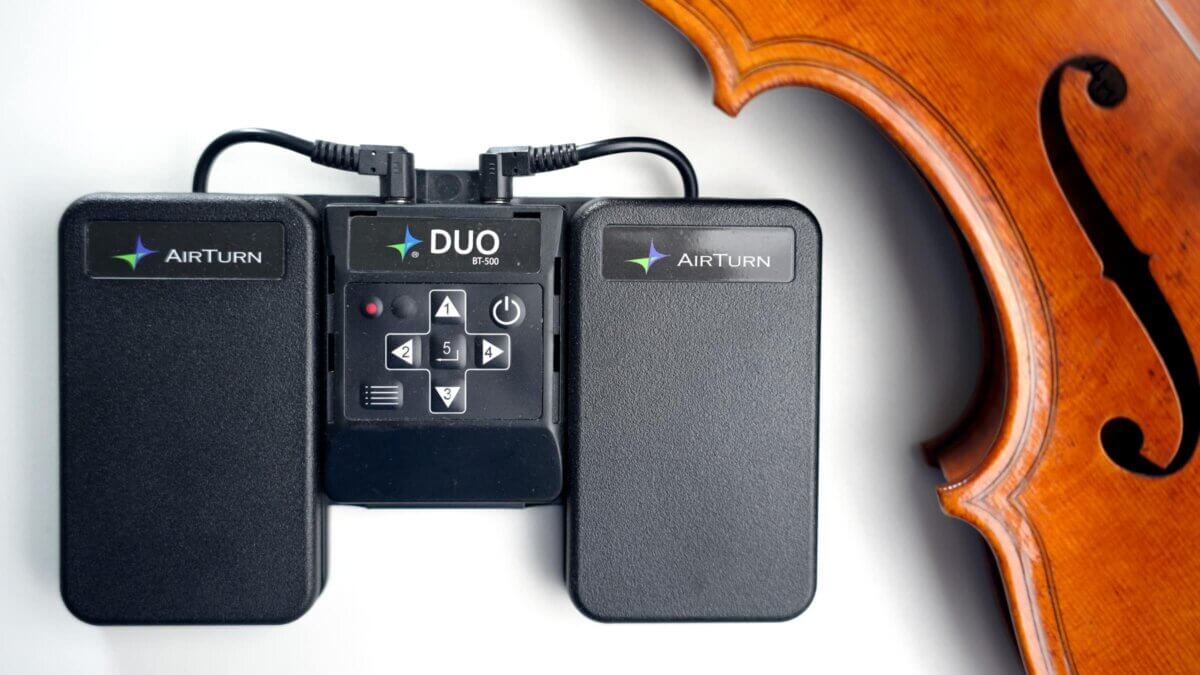
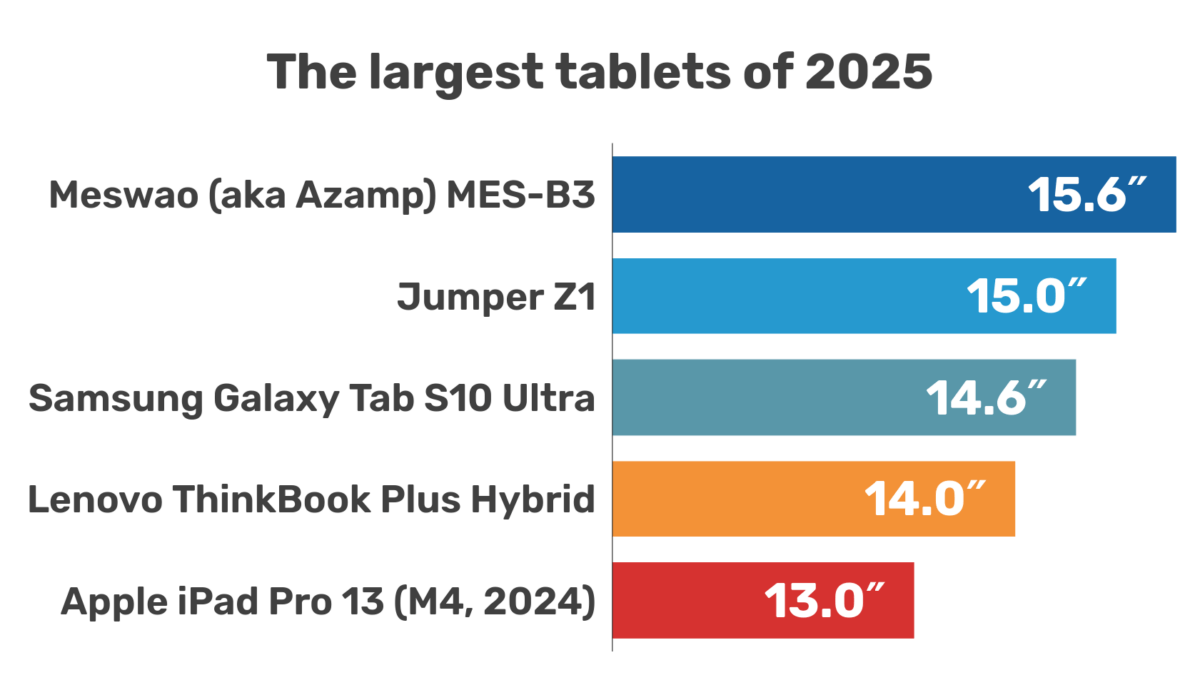

16 thoughts on “The best e-readers for musicians”
Thanks for the comprehensive reviews! It is perhaps useful to keep in mind that fujitsuquaderno.com is not an official Fujitsu website, see
https://www.reddit.com/r/FujitsuQuaderno/comments/1jlnxn3/reminder_that_fujitsuquadernocom_is_not_an/
Meanwhile we also have two Onyx Boox 13″ devices: the Note Max and the Tab X C. Both have relatively dark screens, it will be interesting to see which one gets more preferences by musicians.
Great reviews, thank you!
My eyesight is not great, so I’m looking for the largest screen possible, and also something that is easy on the eyes if I want to read e-books. But I notice the Onyx Boox Tab X does not have a front light. Does this mean if I was performing on a dark stage or with little lighting, it would be too difficult to see? Most people in my ensemble use an iPad pro, but I am after something where I can read books as well (and I hate reading ipads). Just wondering if this front light thing will be an issue. Thanks for the advice!
Hi Joey,
The Boox Tab X (2023) has a front light, but the Boox Note Max (2025) does not.
As a consequence, it is problematic (or impossible) to read music (or anything else) on the Note Max against the light. It gets uncomfortable in low light, but music stand lights can help. So it is really a pity that the Note Max does not have a front light!
I hope this helps!
I’m trying to decide between iPad, Tab Ultra, and an e-ink reader. The recent Boox Note Max announcement is intriguing, although no release date was announced.
Have you used the Sibelius app on the Tab X? I’m wondering how the experience is as I would like to use this device for arranging music in addition to the primary use case of reading music through MobileSheets.
Hi, Greg,
First of all, I’d advise you to check whether the software you intend to use is available on iPad and Android tablets. A 13-inch iPad Pro or a Samsung Galaxy Tab S9 or S10 are really top-notch for reading sheet music, so choose the system (Apple or Android) you prefer!
As for the 13-inch iPad Air, its screen is a little worse than that of the S9 and S10 Ultra: placed next to each other, it’s striking.
I’m (superficially) testing Sibelius for Android on my S9 Ultra, but I’ve never tried it on an e-reader (I’ve sold my Boox Tab X, as its successor will probably be out soon). I think Sibelius is much nicer to use on a tablet than on an e-reader.
For editing music, a Windows 2-in-1 is probably the best solution. Otherwise, there’s a unique device, half Android tablet, half Windows PC, the Lenovo ThinkBook Plus G5 Hybrid. Unfortunately, it’s super expensive, but it’s perhaps the perfect tablet if you want to read sheet music AND use a scorewriter.
Cheers!
As a music teacher I am constantly using my remarkable2… you can cast the screen mark up music etc and send pdfs super easily!!
I am looking at the remarkable pro currently because the backlight could make it usable but yes pageturns are an issue still…. I heard this is going to be fixed in a later update, there is latent Bluetooth connectivity in the hardware! Hoping for the best.. I really enjoy having something dedicated and not connected to the internet directly to distract me with notifications etc.
Dear Johannes,
I have played the oboe for almost 50 years. I’m looking to purchase an e-reader that will enlarge the page, so I can see it more clearly.
The vision in my left eye has been getting more and more blurry over the past year. I need the e-reader to enlarge music, so the screen needs to be the largest possible. Big enough to make the music 5% to 8% larger. I haven’t played an outdoor concert since junior high, so a glare on the screen wouldn’t be an issue.
Which reader would you recommend for the ability to enlarge the pages? Would also need to be able to use a Bluetooth page turner.
Thanks,CB
Dear CB,
Especially because your sight is not good anymore, I would not recommend an e-reader, but a tablet.
I have practiced for hours and hours with a tablet and an e-reader side-by-side, and really, tablets are easier to read most of the time, especially indoors.
To really be able to enlarge music, I can recommend using any of the following tablets in landscape mode. You’ll have to turn pages twice as often, but the music will be really bigger and comfortable to read:
The Samsung and Lenovo tablets are even wider than the 13-inch iPads in landscape mode, which means that the sheet music will get really big!
Any of these tablets will work with any Bluetooth page turner.
I hope this helps!
Johannes
Hello,
A very nice overview and site, thanks. As a professional violinist (somewhat 30 years now) I’m interested in these new way’s of reading music.
My orchestra (NNO, top of Holland) did twice a test with the iPadPro’s from Newzik. The hardware of this device is unique (and way too powerful for only reading and annotating music of course). My biggest problem was – in fact – the screen. I study at home from a 27-inch iMac. Reading from this kind of screens (as you pointed out in e-reader v.s. tablet) is actually very tiring. This is why I write this comment. Your brain sees a picture while looking at a tablet (glass screen). This makes it difficult to concentrate on reading sheet music. In fact, you’re continuous scanning a picture in small parts. Tiring. Therefore an e-reader is always the best choice for (longer) reading sheet music.
Hopefully in the future bigger e-ink readers will be available because the Onyx is unbeatable the best at the moment, but also very small when you are used to playing from B4 format orchestral or chamber music. A music stand with a built-in E-ink screen is in my option the best solution. Keep up the good work,
best regards
Michiel
Dear Johannes
Thank you for comparing different readers and tablets. Could you elaborate a bit more on what you consider “significantly more frustrating” when using an e-reader? For example, does the music build up too slowly when “turning pages”? Does Mobile Sheets only work in a limited way?
I would need the reader exclusively for piano sheet music and e-books, and had hoped that it would have advantages over a tablet in both fields in terms of readability.
Best regards
Bernard
Dear Bernard!
Even before I created this website, I practiced my parts using multiple tablets, an e-reader (PadMu, then Onyx Boox), and printed music side by side on several music stands. With the same score on multiple devices, you instinctively start looking at one device rather than another.
Initially, I thought I would prefer the “paper” aspect of e-readers. But in fact, I almost always look at a tablet rather than an e-reader. Especially indoors (and, oddly enough, in winter when there’s not much light coming in through the windows), I find the displays of e-readers less pleasant to look at.
Outdoors, this changes radically: with lots of natural light/sunlight, e-reader displays become magnificent and tablets displays anemic. So for me, it’s really a matter of light in the work environment.
The slowness of the display on e-readers isn’t a problem when you’re turning pages, but it’s more of a pain when you want to zoom in to annotate scores. There are lots of little details that make using an e-reader less convenient: no double-tap to wake up from sleep, no volume buttons, poorly organized menus, a less intuitive interface, no 5G/cellular option, and so on.
MobileSheets has the same functionality on e-readers as on tablets, so there are no issues in that regard.
I think this will change in the future. E-Ink technology is improving year after year, and so is the quality of e-readers. But for now, for music as for everything else, I still prefer to use a tablet.
Good luck!
Johannes
Hello,
Can you please tell me if it’s possible to easily pair two Onyx Boox readers or Padmu to have two pages? Most of my scores are on two pages, and I’ve been looking for a long time for a way to put them on an e-reader or tablet to play in concert.
Thank you,
Veronica
Hello Veronica,
Yes, it’s perfectly possible to pair two e-readers to display two pages of music side by side. You can connect :
— Two Onyx Boox with MobileSheets,
— Two PadMu with either PadMu Reader or MobileSheets,
— One Onyx Boox and one PadMu, with MobileSheets.
Enjoy your concerts!
Reply directed to Johannes…
Thanks for the response about pairing multiple e-readers to display two pages side-by-side. Do you know when displaying scores in this manner if it is possible to make annotations directly to the page being displayed on the secondary device? I currently use 2 iPad Pros with ForScore and Cue running in dual page mode. The problem I have is if I need to make an annotation to the page on the righthand side I have to turn the primary iPad to landscape mode to make the page appear on that device, make the annotation there, and then return the device to portrait mode to have the annotation appear on the second iPad. This is a cumbersome workaround, especially in the middle of a fast-paced orchestra rehearsal.
Hello and thank you for your site, it’s exactly what I was looking for. I’m a professional musician and I use the 12.9-inch-iPad with forScore, and it works great. But obviously, it’s not as comfortable as my Kobo e-ink e-reader (yes, I read a lot of books), it’s quite tiring on the eyes.
I’m considering buying the Onyx Book Tab Ultra because of its format and the e-ink. On the other hand, forScore won’t run on it, will it? I’ll have to switch to another software. Is there any other software as good as forScore in the Android world? Thank you and have a nice day.
Hello Strav,
Indeed, forScore does not run on the Onyx Boox Tab Ultra*, nor on the “C” variant with color display*, nor on other Android devices. By the way: The Boox Tab Ultra variants have 10.3-inch screens, which are rather small for reading scores.
The Android equivalent of forScore is Mobile Sheets (formerly Mobile Sheets Pro). Personally, I prefer it to forScore.
In my experience, except in specific cases (e.g., if you mainly play outdoor concerts), working with an e-reader is much more frustrating than with an iPad or a good Android tablet.
Best regards,
Johannes